
This magazine offers you greaT digiTal experiences Where you find a Qr code














This magazine offers you greaT digiTal experiences Where you find a Qr code













Cyndie Warbelow is a lifelong Alaskan who grew up first in several remote villages in the northern part of the state. Her family then moved to the Interior where her parents, along with Cyndie and her three brothers, operated a roadhouse and bush flying service on the Alaska Highway, a spot located 120 miles east of the Yukon-Alaska border and equidistant between the two biggest cities in Alaska and in the Yukon. She was home schooled through high school because the nearest school was twenty-five miles distant. She graduated from the University of Alaska with a B.Sc. in biology and from the University of Michigan with an MSc in zoology and did further graduate work in zoology at Oregon State University. On returning to Alaska, she discovered horticulture which led to her career building, owning and operating, and eventually selling two greenhouse-nursery businesses in Interior Alaska. In 2021 UA Press published her book, Northern Garden Symphony: Combining Hardy Perennials for Blooms All Season.
She resides in Fairbanks where she now consults in garden design and teaches classes for the Fairbanks Folk School. Her spare time is spent tending her many display gardens, rescuing cats, being outdoors, writing, painting, and enjoying coffee and food with family and friends. Occasionally she entrusts the gardens and the cats to someone else’s care and visits gardens outside her home state. The opportunity to visit Newfoundland and Manitoba on two of these trips convinced her that the Yukon is not the only Canadian province that shares the gardening climate and unique growing conditions of Alaska.


Follow us online www.localgardener.net
Facebook: @CanadasLocalGardener
X: @CanadaGardener
Instagram: @local_gardener
Pinterest: @LocalGardenerMag
YouTube: @LocalGardenerLiving
Published by Pegasus Publications Inc.
President dorothy dobbie dorothy@pegasuspublications.net
Editor & Publisher
shauna dobbie shauna@pegasuspublications.net
Art Direction & Layout
Karl Thomsen karl@pegasuspublications.net
Contributors
eric Bloom, dorothy dobbie, shauna dobbie, Carla scodopolos, Cyndie Warbelow.
Editorial Advisory Board
Greg auton, John Barrett, Todd Boland, darryl Cheng, Ben Cullen, Mario doiron, Michel Gauthier, Mathieu Hodgson, Jan Pedersen, stephanie rose, Michael rosen, aldona s atterthwaite, and Trudy Watt.
P rint Advertising
Gord Gage • 204-940-2701 gord.gage@pegasuspublications.net
Digital Advertising
Caroline Fu • 204-940-2704
caroline@pegasuspublications.net
Subscriptions
Write, email or call
Canada’s Local Gardener, PO Box 47040
Winnipeg RPO Marion, MB R2H 3G9
Phone: 204-940-2700 info@pegasuspublications.net
One year (four issues): $35.85
Two years (eight issues): $71.70
Three years (twelve issues): $107.55
Single copy: $11.95
Plus applicable taxes.
return undeliverable Canadian addresses to: Circulation department
Pegasus Publications Inc. PO Box 47040, Winnipeg RPO Marion, MB R2H 3G9
Canadian Publications mail product Sales agreement #40027604
ISSN 2563-6391
Canada’s LoCaL Gardener is published four times annually by Pegasus Publications Inc. It is regularly available to purchase at newsstands and retail locations throughout Canada or by subscription. Visa, MasterCard and american express accepted. Publisher buys all editorial rights and reserves the right to republish any material purchased. reproduction in whole or in part is prohibited without permission in writing from the publisher.
Copyright Pegasus Publications Inc.

We have all seen those idyllic looking outdoor dining spaces, complete with pizza ovens, cupboards and counter space, fridges, sinks, fireplaces, and cozy seating. But there are some fundamentals to consider before you start.
Location, location, location
Will the space be primarily used for a place to eat breakfast or lunch or dinner? Or all three?
The first consideration should be the sun. Ideally, the location will receive early sun to warm a cool morning and late afternoon shade to shelter a hot afternoon and evening. Remember that the sun’s position will shift as you go through the summer.
If it is possible to locate the dining area in such a spot, the rest can follow, including the type of plants chosen to surround the space because their success also depends on light and temperature.
If the late afternoon sun cannot be avoided, it will be necessary to provide directional shade, by way of an
umbrella or some sort of awning. There are also very attractive dining tents with tieback screens and curtains.
Wind direction is another consideration. While the ideal space will have air movement, it will also require shelter from more vigorous winds, especially on colder days. This could mean planting shrubs on the windward side of the space or adding some other sort of shelter such as a vine covered trellis. Shelter plants such as these can also help with late afternoon sun exposure.
What about privacy and noise reduction? Are neighbours or passersby able to see directly into the dining space? If so, perhaps a shelterbelt of columnar trees will muffle both noise and prying eyes without invading neighbouring space too much.
What will happen when it rains? Some may rush inside when the heavens open, but the more adventurous will enjoy the experience of being sheltered while the world all around gets a shower. Can guests be protected from

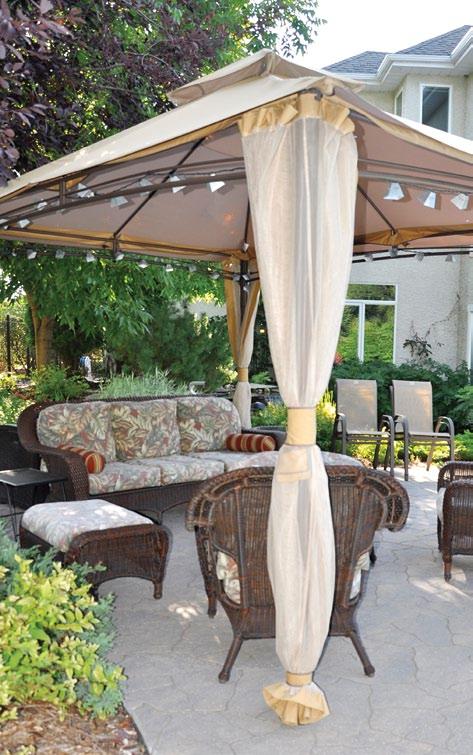


getting wet during such an event? This can be a challenge, even with a canvas cover for the dining area, because water will collect, the canvas will sag and sooner or later somebody will get an unexpected bath! Very large umbrellas or something with a peaked roof is important to allow for rain runoff. A wooden threesided shelter is another option.
Insects may be another consideration. At various times of the year, insects such as mosquitoes, black flies, wasps or even flying aphids invade garden and outdoor dining spaces. That is when a screen comes in handy, but there are a variety of other ways to keep the pests from being too much trouble.
Remember, most insects have their seasons and their time of day. Mosquitoes like it cool and will retire to shady places in the garden until the sun loses some of its power. That’s why they are most of a nuisance at dusk and early in the morning. Wasps generally arrive when they are hungry in the late summer or early fall. They can be deterred by hanging a fake wasp nest somewhere nearby or by wasp traps filled with something sweet or decaying (wasps like beer). Dish covers and dish screens can also help.
Mosquitoes and wasps don’t like several scents and they can be discouraged by burning the good old doodoo coils used by campers and woodsmen. The plants chosen for the space can help. Mosquitoes can be deterred with flowers and ornamentals, among them geraniums (Pelargonium), lavender, salvia, eucalyptus, and marigolds. Herbs such as basil, mint, thyme, and lemongrass can be interplanted in flower boxes and hangers. Wasps don’t like cucumbers.
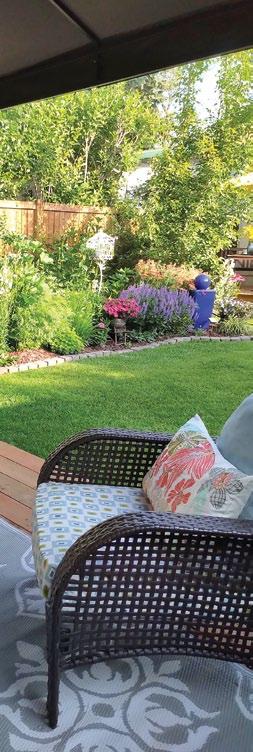

Neither of them likes garlic, but chances are that diners would prefer that the space not reek of that odiferous plant.
Other insects such as flies and aphids, have a very limited time – usually one to two weeks. Keep a dollar store racquet-shaped zapper nearby to ward off the most persistent. Avoid killing the wasps. They will fly away if the zapper gets close. Killing them attracts defenders.
The usual structural options are decks, high or low, or ground level patios and it is assumed that both will be tied to the house. While high decks are naturally housebound (on raised decks be careful to avoid obstructing the seated view with eye-level railings), either the deck or the patio can be located where it makes most sense to the owner.
Floating decks are an option. They are inexpensive to build and have the advantage of not collecting water. They can also create a foundation for the dining tent or covered gazebo. They can be partially walled by raised planters filled with favourite plants and even shrubs, which can create a luxurious surround for an outdoor kitchen if that is part of the plan for the dining area.
Access to the house and to the source of food and cooking is a consideration. You want the barbecue to be easily accessible but not so close that it interferes with the actual dining area.
If opting for a floating deck, provide a stable path to the source of the cooking.
The fun part is making the space beautiful. This can include anything from outdoor carpets to luxuri-



ous seating. Consider a round table for the friendliest dining space that can also accommodate the most people. A lazy Susan in the centre can provide an easy serving station. Overhead coverings can hang from a central pole inserted through a hole in the table or the larger cantilevered umbrellas that max out somewhere around 12 feet across.
Surrounding the dining area with plants is part of the experience. Pay attention to light requirements.
You might also consider lighting for the best summer
Putting in a spot to eat doesn’t need to cost any more than a cheap table and chairs, maybe $150 new or far less if you’re willing to hunt around for used items.
Ikea has an indoor table and 4 chairs on sale for $135.99; add a vinyl tablecloth to protect the tabletop and you’ll be good for a couple of years at

evening experience when the days grow shorter. The simplest is provided by solar lights, although candles add a certain ambience like no other. Place them inside a lantern to keep them burning during a breeze.
Finally, a water fountain and a nearby birdbath can add entertainment as birds come for a drink and a dip attracted by the sound of the water which will also soothe jangled nerves.
The final touch? A sound system to play the music you love. f
least. Or you can get an outdoor table for two for $25 and a couple of folding outdoor chairs for $25 apiece.
Canadian Tire has a 6-foot indoor and outdoor table for $79.99 and folding chairs (presumably for indoors) for $14.29 apiece. Just bring them outside to use and store them in a closet.
If you don’t have a patio or deck, you can put the table and chairs directly on the lawn or you can pick up a cheap indoor-outdoor carpet. Ikea has a lovely one over 5 feet by 7 feet for $99.
Plates and cups can be the same as your indoor ones. Why spend extra money if you don’t need to?






BOB’S SUPERSTRONG GREENHOUSE POLY.
10 & 14 Mils. Pond liners. Resists hail, snows, winds, yellowing, cats, punctures. Long-lasting. Custom sizes. Free samples.
Email: info@northerngreenhouse.com
www.northerngreenhouse.com
Ph: 204-327-5540 Fax: 204-327-5527
Box 1450 Altona, MB R0G 0B0
To place a classified ad in Canada’s Local Gardener, call 1-888-680-2008 or email info@localgardener.net for rates and information.
Join the conversation with Canada’s Local Gardener online! www.localgardener.net
Facebook: @CanadasLocalGardener
Instagram: @local_gardener
X: @CanadaGardener

Doyle and Michele Piwniuk have created the perfect dining-sitting area, complete with a kitchen preparation and storage area, a pizza oven, and a fireplace for cool evenings. They have surrounded their garden courtyard with densely planted trees to create seclusion from their nearby neighbours. This also prevents wind from spoiling the fun, while allowing air to circulate. A threeseason greenhouse for potting completes the plan.
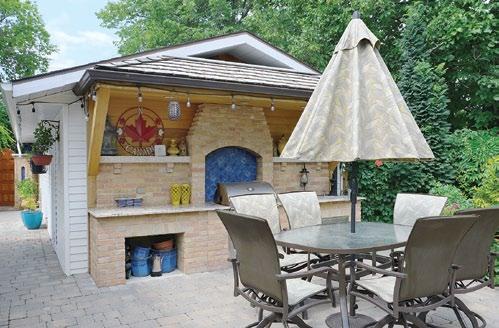




Wouldn’t you love to create an edible garden that is beautiful to behold? Of course, there is something beautiful about veggie plots no matter how you plant them, with support sticks in the air and string hanging between them and maybe even a halfhearted scarecrow. This is the unintentional beauty that comes from memories of times we have spent in such places and contentment we have felt from our activities there. This article, though, will discuss making your vegetable garden an ornamental garden: the steps you can take and elements you can design to grow your produce in the most attractive way possible.
Location
First, of course, you must situate the veggie garden in an area with plenty of sun, at least six hours per day over most of it. You will plant any fruit trees to the north side and generally put in plants going from tallest to shortest south of that. Beyond that, the world is your oyster and you can design as you see fit.

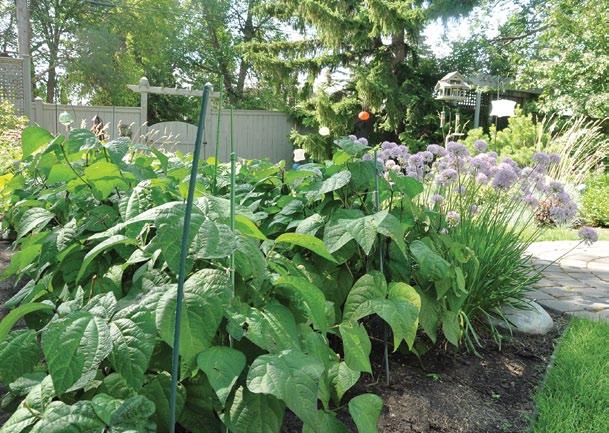
Mix ornamentals and edibles together.
To get away from the veggie look, think beyond the rows. The craze for square-foot gardening helped many people think outside of rows in their plantings. Certainly, you must be able to reach well around any veg plant to tend to it and harvest from it, but that does not mean you must plant in rows that are 2 feet wide. Keep that in mind as you plan the paths of the garden.
Paths
In your design, the paths go in first, and they can take whatever shape you find pleasing. Make them curvy or geometrical but make them 2 feet wide. Some readers will decide skimp and make the paths 18 inches wide, but those same readers will be making their paths wider the following year.
Consider making the paths symmetrical for a polished


Your garden paths can be as ornamental and funky as you like.
look. For more advanced designers, seek to achieve balance if not symmetry.
Now, what will the paths be made of? If you use bricks, you will need to lay them properly, with a base and a border around them. The same is true with gravel, which will soon be filled with soil spillage and weeds. If you are cutting the garden out of a lawn, you can carefully make lawn paths, but they will require frequent edging. It might be easiest to lay a good, thick layer of bark mulch along the paths, or mulch with flagstones atop.
Whatever you choose, let it be something that makes your heart sing when you see it.
Raised elements
Now you should think about whether you want to


Practical can also become ornamental – fences and barriers don’t have to be ugly.

put in any raised beds or big pots. If you are planning an all-curvy garden, you will need either curvy containers (round will do) or a skilled carpenter to build curvy raised beds. It is much easier to build straight-edged raised beds. Those straight-edged beds don’t need to have 90-degree corners, though.
On this subject, see also “Vegetable gardening the Italian way” on page 26.
Supports
Where would you like to put string beans and cucumbers? Think about what you can use for supports that is attractive rather than just useful. Garden centres abound with trellises and arbors for clematis and roses; purchase these instead of the utilitarian wire forms. The trellises and arbors are more expensive, but they do not need to be replaced every year or two.
Do you have a statue or some other large piece of garden art? Make it a focal point for your veg patch. Place it at the end of a long pathway to make it a destination for the eyes or place it at the very centre of the garden. Maybe it could be a fountain, which would add sound.
Think of this garden in three dimensions. Consider the height of its contents. Do you want to attract pollinators? Put in a tall pot of marigolds or plant some hollyhocks near the back of the garden.
The most experienced ornamental gardeners are adept at putting the right flower colours and textures together. Most of your vegetables have emerald-green foliage but

Have attractive supports for your vegetables.
think about using a few that don’t. Bluish cabbages, purple asparagus, bloody dock, red lettuces. Then there is the fruit of the vegetables: tomatoes in red, purple and yellow or squash in yellow and orange. Eggplants and peppers add colour too.
Your garden will change from spring to fall. Think of the colours, from the tender greens of May through to the hard orange pumpkins of October.
For texture, think about the ferny leaves of asparagus as it goes to seed. That texture can be contrasted with the bigger foliage of zucchini. Bushy basil would look lovely next to smooth lettuce. Upright cos lettuce contrasts with round butter crunch.
One bonus to beautifying your veggie plot is that most of the plantings are annuals; if you don’t like the contrast this year, switch it up next year.
Edging and borders
What surrounds your garden bed? Perhaps you prefer the hard-working aesthetic of deep, crisp edges dug into the lawn, which don’t make much of an impression from a distance. Add some colourful plantings of pollinator attracting flowers just inside your edging trenches to set them off.
You could also add rabbit fencing or stones surrounding the vegetable garden. You don’t have to do anything, of course, but if you do put in a terminal accent it will give the viewer a sense that this is a complete and finished garden.
Consider adding lighting here, too. It will be useful for late-night gardening binges and look beautiful in the fall when visitors are over for dinner. f


Winters in most of Canada are cold and white and so when spring arrives gardeners are starved for colour. We run to the garden centre and buy the first blooming beauty we see. If it is something new or unusual, we go for that, too.
The problem with this impulse buying is that it can bring only shortterm pleasure, and it is expensive. So, let’s take a considered look at the basics of creating an all-season garden. It will consist of more than just potted annuals and even perennials.
Gardeners should be thinking a season or two ahead for the best allseason garden.
Let’s start with winter plants first, because in many ways this season is the most challenging, but you may only be able to find the plants in springtime.
The all-season gardener looks for shrubs and trees that will provide winter interest with height, width, shape, stem, or trunk colour, foliage, fruit and bird preference.
Evergreens are important but think carefully about how much room they might take in your garden. A smaller garden might want to stick with a dark green columnar cedar or some bluish juniper or even some chartreuse coloured cypress in warmer, zones 6-and-up areas of the country.
Nearly everyone can grow dogwood with its bright red, orange, yellow or lime green stems; or willows which also come in a wide variety of shades from green to golden to red and purple. When it comes to willows, think about pussy willows for early interest. Bring some cuttings inside in March or early April (unless you are allergic) and watch the pussies appear. For that matter, many spring flowering shrubs will reward you with some early indoor blooms if you cut them and put them in water when the buds are forming.

Evergreens provide structure in the winter.
Bark shade matters, too. The white and black standards of birch or poplar can romance a winter scene. Amur cherry bark is a glowing cinnamon that curls and peels much like birch. There are many other tree choices that have shining, peeling or beautifully coloured bark. Ask for these details at your local nursery.
Birds in the garden add winter life and interest. Certain trees attract birds, especially those that keep their fruits well into the winter. Once again, dogwood is on the list but so are several crabapples, mayberry and even some apples that cling to their fruit. Saskatoons or, as some call
them, serviceberries offer winter food as do white oak, grape and Virginia creeper vines, staghorn sumac and many others. Blue jays are attracted to Amur maple seeds.
Evergreens such as spruce and cedar provide both food for some birds and shelter for many.
Grasses and late blooming perennials such as echinacea (purple coneflowers) provide both aesthetic interest as well as food.
What about spring? Even before the garden centre opens, the spring garden can be beautiful and blooming. Fall planning and planting is crit-

ical to this experience. And fall is also the time to plant garlic!
All those lovely tulips and daffodils, hyacinths, iris, allium, and tiny scilla and grape hyacinth were planted some previous autumn. Designers advise planting bulbs in odd numbered groups of five or seven or more. Plant tiny bulbs in patches. They will spread over the years and provide a pleasing carpet in the early spring.
The prairie crocus (fuzzy Pulsatilla patens) is very rewarding as it is one of the first plants to emerge with the warming sun.
And did you know that you can plant those grocery store primula in a damp, shady cool spot that gets early spring sun for a beautiful display the next year? The trick in cooler parts of the country is keeping them alive long enough to plant out when the ground thaws. They need to be carefully watered and not allowed to dry out.



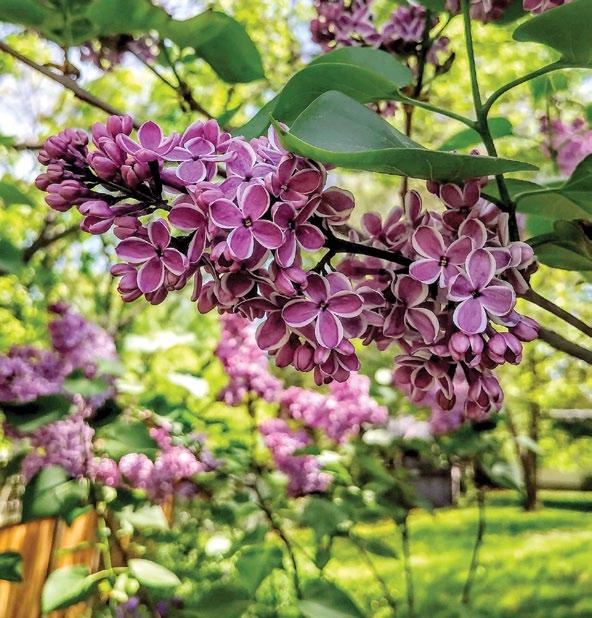

Some annual seeds are happy to be planted directly outdoors as soon as the ground has thawed. Among these are sweet pea vines and pansies. In higher zones, you can plant these seeds the previous fall. On the prairies, you will want to wait six to eight weeks before the last frost in springtime or when the topsoil reaches between 8 and 12 Celsius.
If you have been looking at shrubs and trees, you will have already considered blooming and bloom times, a big part of the magic in spring gardens. The scent of apple blossoms, lilacs, and mock orange, to name just a few, provides a heady introduction to what is ahead.
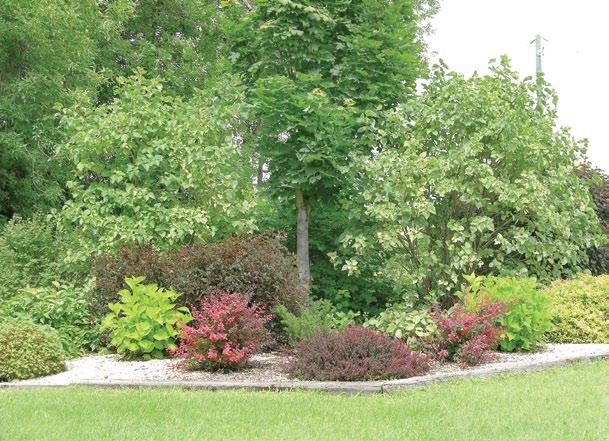
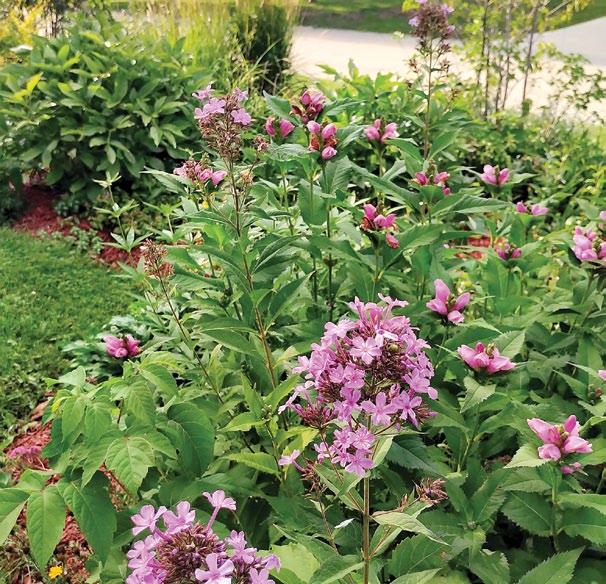
Be intentional when shopping for perennials. Think about the perennials you love and when they will bloom. Most keep their blossoms for just for a week or two, depending on how hot it gets, but there are some that can produce more flowers with deadheading and others that have a three- or four-week blooming time.
Know that not all perennials will bloom the first year you buy them. Some, like daylilies, hydrangeas, and peonies, may take a year or two to get started. Take that into consideration and don’t rely on being prompted to buy them by their brilliant blooms at the garden centre. They won’t be blooming when you are shopping in spring.
Indeed, some annuals or perennials that we plant as annuals in our cold climate will also be late bloomers. The stunning lisianthus blooms in mid to late summer and you need to think ahead to purchase them as small plants with no flowers. Winter seed planters will start them in January. Tall Phlox paniculata is a July to August bloomer but blooms for several weeks, especially with careful deadheading.
Roses are another example. Some roses bloom only in spring or early summer and some bloom again in fall. Delphiniums bloom in early summer but cutting them back can bring a later reward. Hot July can be a down time for many perennials that like things a little less scorching.
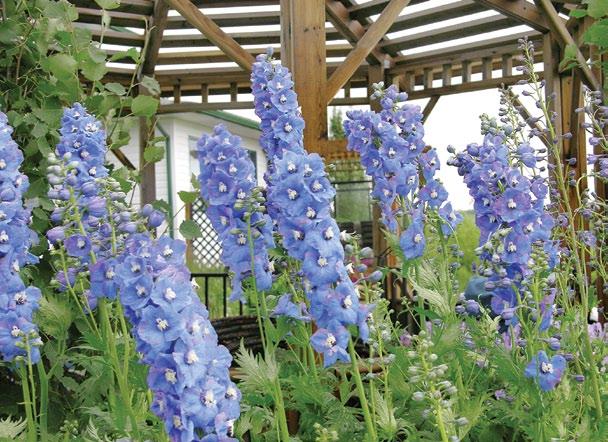

But lilies and daylilies thrive in these conditions.
When August dawns so do gladiolus and cannas. Turtlehead starts to come alive. The asters come into their own and heady chrysanthemums add brilliant colour.
You need to look carefully at what works in your climate.
Autumn
Now the days grow shorter and cooler, but planting time is accelerated because we are gifted with a whole new batch of planting choices. Now is the ideal time to plant trees and shrubs. Planting in fall gives them time to establish roots and get an early start in the springtime.
This is also the time, as we
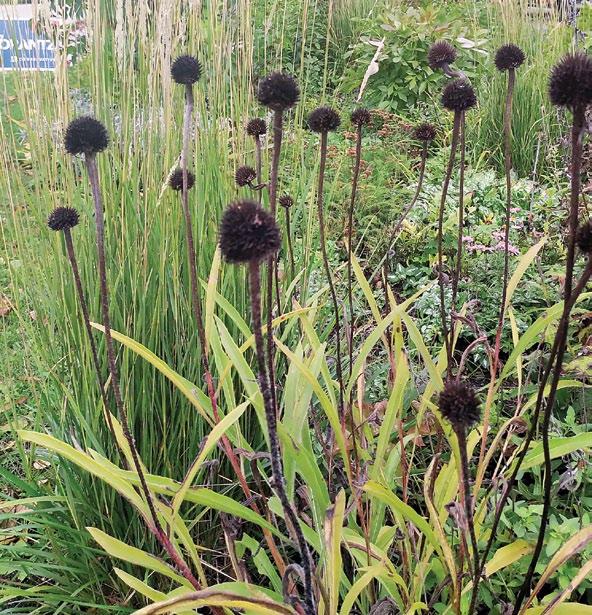

mentioned earlier, to plant many bulbs. But here is something you may not know: spring is also a great time to sow outdoors the seeds of a whole list of self-sowing annuals and perennials. The stores will be full of seeds that work in local conditions, among them delphiniums, many types of daisies, marigolds, powder puff asters, some poppies, sunflowers, zinnias, calendula and many more (cosmos, bachelor buttons, four-o’clocks, morning glories, sunflowers – it is a very long list.) Planting from seed rather than plugs is much more cost effective in these days of inflation and high costs.
And of course, when you planned your garden last winter, you thought about fall foliage.
Fall is the favourite season for many folks, when the glorious foliage colours or trees and shrubs are at their best. The brilliant reds of maples, Amur, Tatarian and sugar, golden aspen, green ash, and tamarack (larch), the orange of white ash, the purple of some ornamental tree varieties, the dull orange-brown of bur oak and the very wide variety of shrubbery foliage colour present many choices. Think about all of this when choosing trees to complement your garden. Remember to set this off with the dark beauty of conifers, in dark greens, blues. And one last note: evergreens, even blue spruce, become darker in winter, a lovely thing against the snow. f

In the vast mosaic of Canada's landscapes, from the rainkissed coastlines of British Columbia to the rugged highlands of Newfoundland, lies an often-overlooked treasure trove: native plants. Growing native plants in your garden isn't just a gardening trend; it's a journey towards ecological harmony and a tribute to Canada's diverse natural heritage.
Before delving into the world of native gardening, it's crucial to recognize that Canada's vastness encompasses a multitude of ecosystems. What thrives in the temperate rainforests of the Pacific Northwest may struggle on the Prairies, and it may not be native in both places. Therefore, understanding your local ecosystem is the first step. Local nature centers and native plant societies can be invaluable resources for this.
The benefits of going native
1. Supporting local wildlife. Native plants have evolved alongside local wildlife and are adept at meeting their needs. By planting native, you offer a haven for bees, butterflies, birds, and other wildlife, fostering biodiversity.
2. Eco-friendly gardening. Native plants are adapted to their specific climate and soil conditions, reducing the need for fertilizers, pesticides, and excessive watering. This harmonious relationship with the local environment promotes sustainability.
3. Year-round beauty. Native plants offer a succession of blooms, foliage, and seeds throughout the seasons, ensuring your garden is always a vibrant and dynamic place.
How to start your native garden
1. Research and plan. Identify plants native to your region. Consider factors like sun exposure, soil type, and moisture levels. Plan your garden layout, keeping in mind the mature size and blooming periods of different plants.
2. Source responsibly. Obtain plants from reputable nurseries that specialize in native species. Avoid wild harvesting, which can damage ecosystems.
3. Plant with purpose. Group plants with similar needs together. Consider creating habitats like a butter-
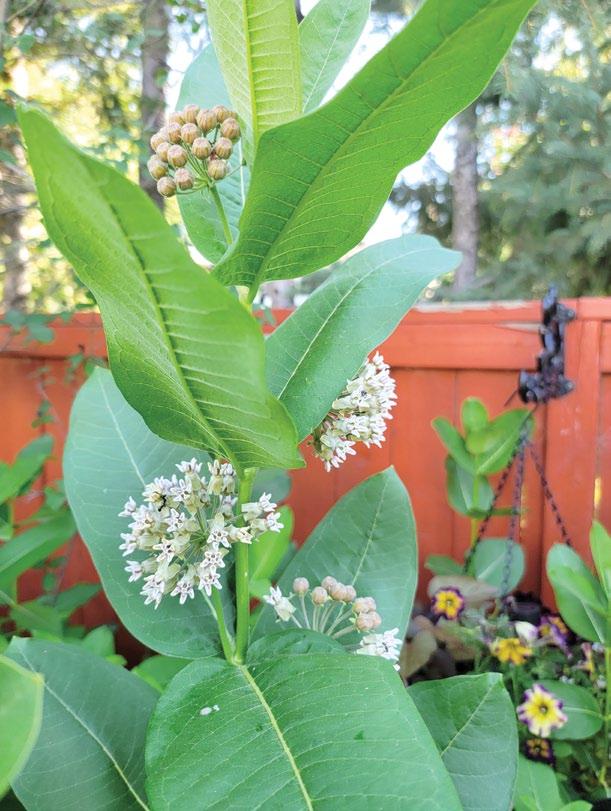
local environment.
4. Embrace natural growth. Native plants may not conform to traditional garden aesthetics. Embrace their natural, wild appearance, understanding that each plant plays a role in the local ecosystem.
Challenges and solutions
While native gardening is rewarding, it can have challenges. Invasive species, for example, can be a threat. Regularly educate yourself and participate in local eradication efforts where necessary. Additionally, climate change is altering habitats; stay informed about how these changes affect local flora and adapt your gardening practices accordingly.
Growing native plants is more than just gardening; it's a continuous learning journey and a profound way to connect with the land. It's about nurturing not just plants, but also the birds, insects, and animals that rely on them. It's about respecting the uniqueness of each region in Canada and celebrating the natural beauty inherent to each one.
By embracing native plants in your garden, you're not just enhancing your immediate surroundings; you're contributing to the broader tapestry of Canadian ecology. It's a journey filled with discoveries, challenges, and the deep satisfaction of knowing you're part of something bigger – the stewardship of Canada's natural legacy. f







Pacific dogwood (Cornus nuttallii). Native to British Columbia, known for its large white flowers.
Saskatoon berry ( Amelanchier alnifolia). Found across the Canadian Prairies, this shrub produces edible berries and has lovely spring blossoms.
Prairie crocus (Pulsatilla nuttalliana). A herald of spring in the Prairies, known for its delicate purple flowers.
Common milkweed ( Asclepias syriaca). Found throughout Southern Canada, it’s crucial for monarch butterflies.
Wild bergamot (Monarda fistulosa). Widespread across Canada, this plant attracts bees and butterflies with its lavender flowers.
Blue flag iris (Iris versicolor). Native to Eastern Canada, particularly in wetlands, known for its striking blue flowers.
Black-eyed Susan (Rudbeckia hirta). A vibrant wildflower found in many parts of Canada, adding a splash of colour to gardens.
Red osier dogwood (Cornus sericea). Widespread in Canada, recognized for its red stems and white berries.
Trillium (Trillium grandiflorum). A classic woodland wildflower native to Ontario and Eastern Canada.
Fireweed (Chamerion angustifolium). Common in recently disturbed areas across Canada, known for its magenta blooms.


Labrador tea (Rhododendron groenlandicum). Found in bogs and wetlands across Northern Canada, notable for its evergreen leaves and white flowers.
Snowberry (Symphoricarpos albus). Grows in many parts of Canada, known for its white, puffy berries.
Bearberry ( Arctostaphylos uva-ursi). A low-growing groundcover native to much of Northern Canada.
Purple coneflower (Echinacea purpurea). Native to Central Canada, popular for its medicinal properties and purple-pink flowers.
Globe thistle (Echinops bannaticus). Found in Eastern Canada, known for its striking spherical blue flowers.
Sea thrift ( Armeria maritima). Native to the Atlantic coast, this plant is known for its tufts of pink flowers and tolerance of salty conditions.
Canada anemone ( Anemone canadensis). Widespread across Canada, this perennial is known for its beautiful white flowers and deeply cut leaves. It thrives in moist, well-drained soils.
Lupine (Lupinus spp.). There are 28 native lupines growing in the country. They are recognized for their tall, colourful spikes of flowers, ranging from purple and blue to pink and white.
Wild columbine ( Aquilegia canadensis). This charming flower, native to Eastern Canada, features unique, nodding red and yellow flowers. It’s especially popular with hummingbirds.
Paintbrush (Castilleja spp.). Some varieties of paintbrush are native to various parts of Canada, especially the West. Paintbrushes are known for their vibrant bracts that come in shades of red, orange, and yellow, mimicking the appearance of a painter’s brush.



In an era of environmental consciousness, the concept of sustainable gardening has gained significant traction among gardeners worldwide. A sustainable garden goes beyond mere aesthetics, focusing on environmental health, resource efficiency, and a balance with local ecosystems.
Sustainable gardening involves practices that reduce harm to the environment and contribute positively to the local ecosystem. This includes using fewer chemicals, conserving water, promoting biodiversity, and utilizing renewable resources. The goal is to create a garden that thrives naturally and in harmony with its surroundings.
Here is how you can cultivate sustainability.
1. Choose native plants. Start by selecting native plants for your garden. Native species are adapted to the local climate and soil, requiring less water and fertilizer than non-native species. They also provide essential habitat and food sources for local wildlife, including bees, butterflies, and birds. (See the article on page 14.)
2. Water wisely. Water conservation is a crucial aspect of sustainable gardening. Opt for drought-tolerant plants and use mulch to reduce evaporation. Collect rainwater in barrels and consider installing a drip irrigation system to deliver water directly to plant roots, minimizing waste.
3. Embrace organic practices. Eliminate the use of chemical pesticides and fertilizers, which can harm the environment and local wildlife. Instead, opt for organic alternatives or make your compost. Composting kitchen scraps and garden waste not only reduces landfill waste but also enriches the soil with essential nutrients.
4. Encourage biodiversity. A diverse garden supports a healthy ecosystem. Incorporate a variety of plants to attract different species of insects and birds. Install features like birdhouses, bee hotels, and birdbaths to encourage wildlife to visit and reside in your garden.
5. Practice crop rotation and companion planting. If you have a
By Carla scodopolos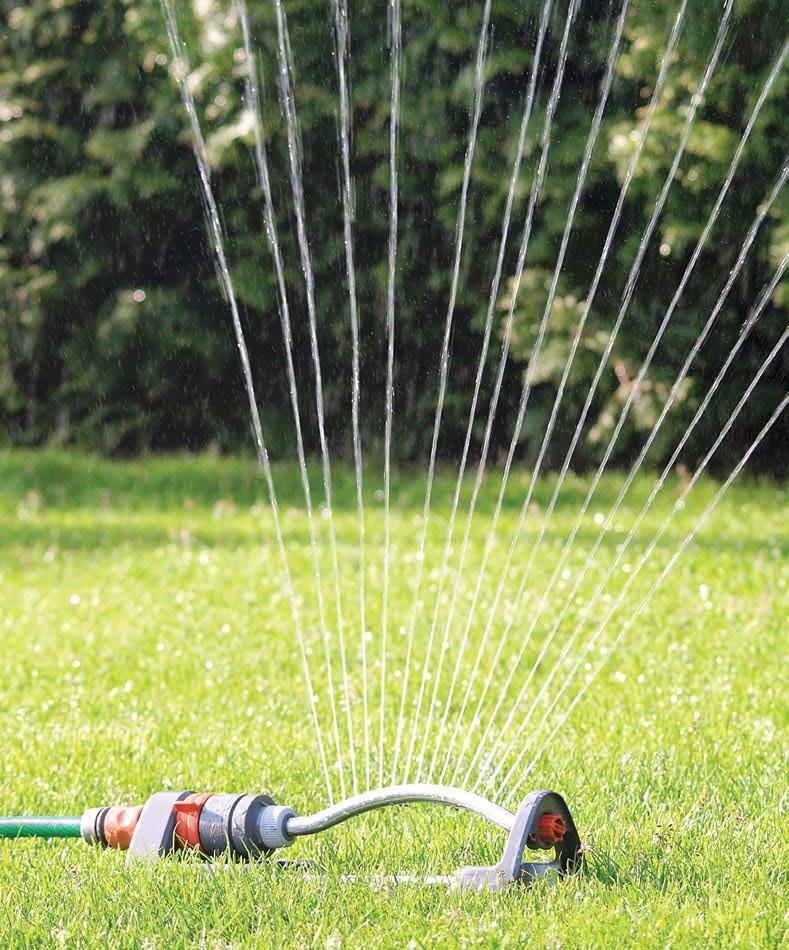
vegetable garden, rotate your crops annually to prevent soil depletion and reduce pest infestations. Companion planting, where certain plant combinations mutually benefit each other, can also enhance soil health, deter pests, and improve yields.
6. Use natural pest control. Instead of chemical pesticides, opt for natural pest control methods. Introduce beneficial insects like ladybugs and lacewings to control aphid populations. Use barriers and traps for larger pests, and plant species
that naturally repel insects.
7. Reduce lawn space. Traditional lawns require significant water and maintenance. Consider reducing lawn space by replacing it with native ground covers, vegetable beds, or droughttolerant landscaping.
8. Use renewable resources and recycled materials. Choose garden tools and accessories made from renewable or recycled materials. Use repurposed items for planters and garden decorations, reducing waste and adding unique character to your garden.





9. Harvest and save seeds. Saving seeds from your plants not only saves you money but also ensures that you are planting varieties well-suited to your garden's specific conditions. It's also a step towards self-sufficiency.
10. Minimize soil disturbance. Limiting soil disturbance helps maintain soil structure and protects the living organisms within it. Practice no-till gardening or use gentle hand tilling methods to prepare beds without significantly disrupting the soil.
11. Incorporate permaculture principles. Permaculture is a design system for sustainable living and land use. Incorporating its principles, such as creating no-waste systems and designing gardens to mimic natural ecosystems, can significantly enhance your garden's sustainability.
12. Educate yourself and stay informed. Sustainable gardening is an evolving practice. Stay informed about the latest sustainable gardening techniques and continuously seek to learn more about how your garden interacts with the local environment.
13. Share and inspire. Share your experiences and knowledge with other
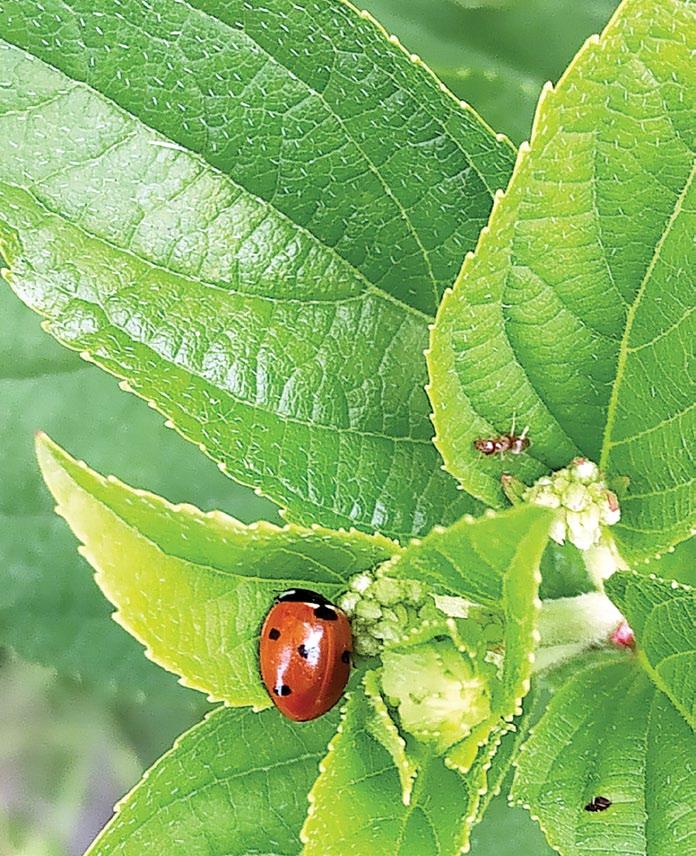
gardeners. Encourage your community to adopt sustainable practices, fostering a collective effort towards environmental stewardship.
Challenges and solutions
Transitioning to sustainable gardening can come with challenges. You may encounter pest outbreaks or plant diseases that are more difficult to manage without chemicals. The key is patience and a willingness to experiment and learn from failures. Often, natural systems take time to establish a balance.
Sustainable gardening is not just a method of gardening; it's a philosophy that embraces a deep respect for nature and a commitment to environmental stewardship. By following these steps, you can create a garden that not only brings joy and beauty but also plays a crucial role in supporting a healthier planet. The journey towards a sustainable garden is ongoing, filled with learning and discovery, and every small step you take makes a significant difference in the bigger picture of ecological balance and conservation. f Insect hotels
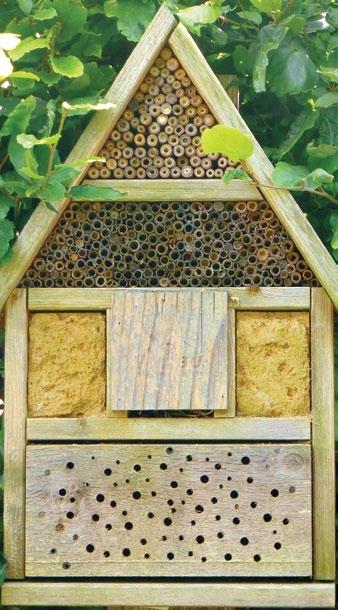

In the picturesque landscapes of Italy, where space is often at a premium, inventive gardening methods have evolved over centuries. One such method that stands out for its efficiency and beauty is vertical vegetable gardening. This approach not only maximizes space but also adds an aesthetic charm to Italian gardens, balconies, and terraces. Here is an overview of vertical vegetable gardening à la Italiana, offering a guide to readers looking to adopt this space-saving and productive method.
Italy's history with vertical gardening dates back to the Roman times when agricultural innovators sought ways to cultivate more food in less space. Over time, these techniques evolved, blending with the art of landscaping, which is a cornerstone of Italian culture. This fusion of utility and beauty is what sets the Italian style of vertical gardening apart.
Vertical gardening is the practice of growing vegetables upwards rather than spreading them out horizontally. This method is especially beneficial in urban settings or small gardens where ground space is limited. By growing vertically, gardeners can increase yield per square foot and make gardening more accessible.
1. Trellising and espalier. Italians widely use trellises and espaliers to train plants to grow against a flat surface or frame. This technique is particularly popular for tomatoes, beans, and vine vegetables like cucumbers and zucchini. Espalier, traditionally used for fruit trees, has been adapted for vegetables, creating not only a space-saving solution but also a living art form.

2. Tiered planters and terraces. Many Italian gardens feature tiered planters or terraces that utilize vertical space. This method allows for growing a variety of vegetables on different levels, ensuring that each plant receives adequate sunlight and air circulation.
3. Hanging baskets. Hanging baskets are not just for flowers in Italy. They are also used for growing vegetables like cherry tomatoes, herbs, and smaller pepper varieties. These baskets are often hung from balconies, patios, or even window ledges.
4. Vertical pallet gardens. Repurposing wooden pallets into vertical
gardens is a trend that has caught on amongst Italians in North America. Pallets are used to create vertical planters for herbs, lettuce, and other leafy greens, making it a popular choice for urban gardeners.
Not all vegetables are suitable for vertical gardening. To grow upwards, select varieties that are either naturally climbing or can be easily trained to grow upwards. If you want carrots and potatoes, plant them elsewhere. Some of the popular choices include:
• Tomatoes: Especially the smaller varieties like cherry or grape tomatoes.

• Beans and peas: These naturally climbing plants are ideal for trellises.
• Cucumbers and zucchini: With proper support, these vine vegetables thrive vertically.
• Leafy greens: Spinach, lettuce, and herbs do well in pallet gardens and tiered planters.
1. Space efficiency. The most obvious benefit of vertical gardening is the efficient use of space. It allows gardeners to grow more in a smaller area, an ideal solution for urban settings or small backyards.
2. Improved plant health. Vertical gardening promotes better air circulation around plants, reducing the risk of disease. It also makes it easier to inspect plants for pests.
3. Ease of harvest. With plants at eye level and above, harvesting becomes easier and less physically demanding. This aspect is particularly beneficial for elderly gardeners or those with mobility issues.
4. Aesthetic appeal. Vertical gardens are not just functional; they are also beautiful. They add greenery and life to


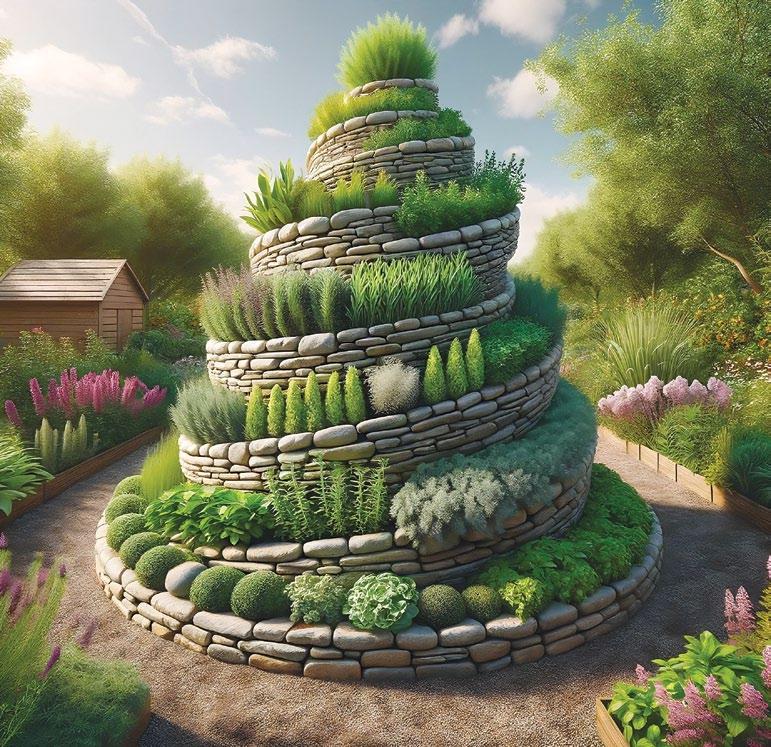

They aren’t just for strawberries, you can grow small tomatoes and cucumbers in a hanging basket.
urban environments and can be a form of artistic expression.
1. Watering. Ensuring even watering can be a challenge in vertical gardens. Drip irrigation systems or self-watering planters are often used to address this issue.
2. Weight and support. The weight of soil and plants requires sturdy support structures. Use robust materials and secure anchoring to ensure safety and stability.
3. Sunlight. Ensuring all plants receive adequate sunlight can be tricky. This is often managed through careful plant selection and positioning. In general, the taller plants and those that tolerate shade grow to the north. f



Creating garden sculptures as a beginner with limited tools is a fun and rewarding project. It may also be quite frustrating and involve many false starts and failures. Look for many instructional videos online for ideas and to get used to the concepts involved.
Here is a basic model to follow for a sculpture that starts with an armature and adds to the outside of it.
1. Choose your material. If you’re a beginner with limited tools, consider using materials that are easy to work with and weather resistant. Concrete, plaster, or a mix specifically designed for outdoor sculptures are good choices. These materials are durable and can withstand various weather conditions.
2. Design your sculpture. Start with a simple design. Sketch your idea on paper first if you like. It’s surprising how much is missing when we just imagine something! Keep the design straightforward, especially for your first project.
3. Create a framework. For concrete
se an exercise ball or other blow-up ball. Make sure to fill it with air so that there is no give.
Cover the entire ball with cement board tape.
Start applying the outdoor plaster or concrete, leaving a big gap at the vent hole if you want to let the air out to retrieve the ball; you might like your project so much you want to make another! Also, if you make the big gap circular, your concrete ball will sit stably.
You may wish to apply several thin layers of material to cover the ball, depending on what you use. You want the walls of your orb to be fairly thick, but you don’t want them to crack.

Check
You can apply different decoraScan

https://www.youtube.com/watch?v=duxDnS5KyIY
tive materials that you then cover with another layer of material. Rope looks fantastic! Or you can make concrete shapes from molds you buy or make.
When the ball is dry and cured, you can leave it as is or apply paint or stain. And finally, coat the whole thing with a weatherproof sealer.
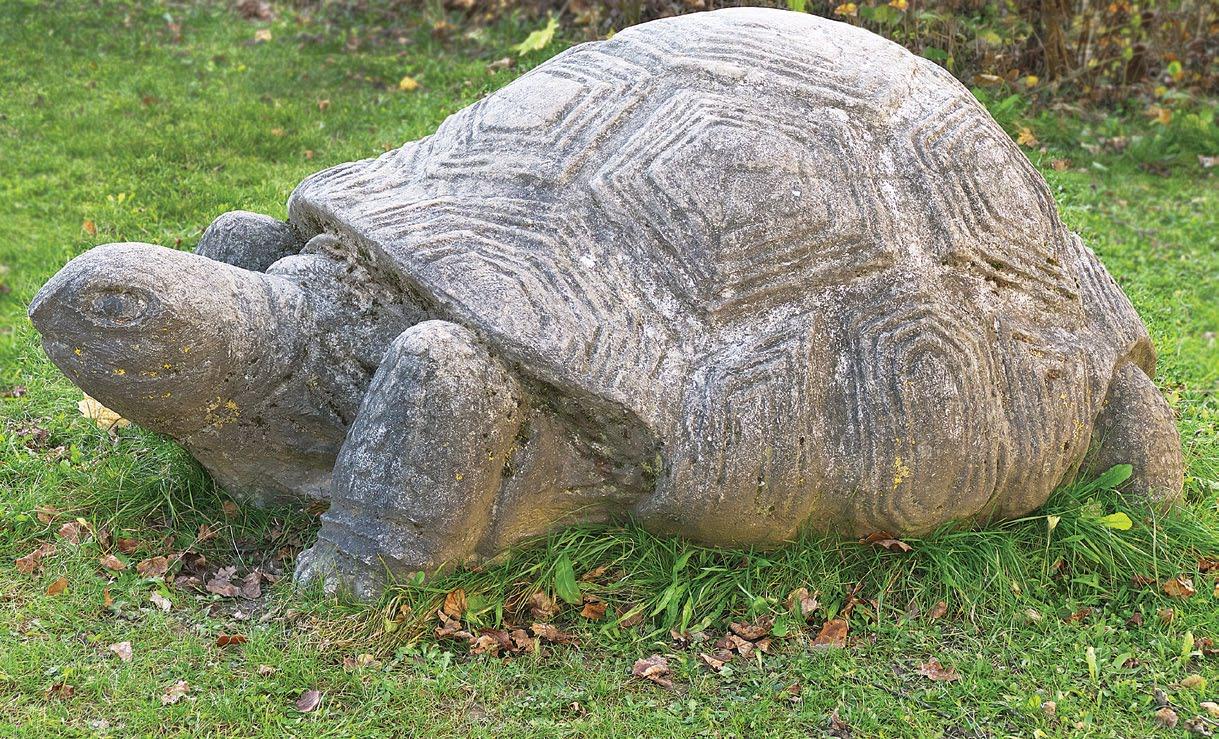






or plaster, you'll need a frame to hang it on. You can use items like old containers, aluminum foil, or you can work with chicken wire to mold something into the shape you’re looking for. You can even make a frame out of cardboard and duct tape. Or you can work with all of these together.
4. Cover with cement board tape. This will be necessary to ensure some materials stick to the frame.
5. Mixing the material. Follow the instructions on the packaging of your concrete, plaster, or sculpting mix. Ensure it's mixed to the right consistency. A thicker mix will start to set sooner, but a thinner mix will be harder to work with and impossible to mold.
6. Apply your material. Slap your material into or onto your mold or framework and smooth it out. You have a limited time to do this and mold any details into it. The setting time could be anywhere from 30 minutes to three hours.
7. Let it cure. Allow your sculpture to cure as per the instructions. This could take anywhere from a few hours to a few days. Just because it is dry to the touch does not mean that it is dry all the way through.
8. Remove the mold (if necessary). Once cured, carefully remove the mold. If you used a wire framework, your sculpture should be already free-standing.
9. Finishing touches. Sand any rough edges with sandpaper, depending on the material you used. You can also paint your sculpture with outdoor paint or apply a weather-

Scan me
Check out this website to find out about a weatherproof papier-mâché clay that artist Jonni Good has developed.

https://www.ultimatepapermache.com/ weatherproof-paper-mache-clay
Materials that are easier to use and weather resistant are polymer-modified plaster and hypertufa. A third is a kind of papier-mâché-cement mix. Look into that one by following the QR code.
For polymer-modified plaster (or concrete), just make plaster using polymer instead of water.
To make hypertufa, mix equal parts Portland cement, peat moss, and perlite or vermiculite, then add water until the mixture reaches a moldable, cottage cheese-like consistency. Mold it into your desired shape and let it cure for 24 to 48 hours before unmolding and allowing it to fully dry.
resistant sealant to protect it further.
10. Placement in garden. Choose a suitable spot in your garden where your sculpture will be most appreciated. Consider how it will blend with the plants and other elements in your garden. f


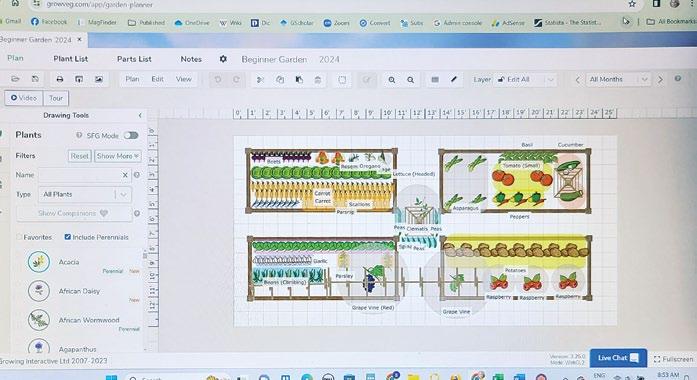


If you’ve been contemplating designing your garden on your computer, here are a few apps to get you started.
Growing Interactive. A number of online design apps come from a company called Growing Interactive. You can sign up for it through GrowVeg (their own entity), Old Farmer’s Almanac, Mother Earth News, Sutton Seeds and more. It’s the same app wherever you get it, but it is good.
Growing Interactive has dragand-drop features to make it easy to use without prior experience. There is a learning curve, but most people figure it out pretty quickly. There is a wide range of design elements (plants, structures, paths and so forth) and it is quite versatile for designing various garden styles and layouts.
It also has lists of many, many general plants; for instance, you can drag and drop an allium, and it requires space of 1 foot in every direction. That may be true for some alliums, but not all. You can put the plants closer together than the general recommendation.
This app also has an online journal where you can keep track of all your thoughts and feelings, by day, and include how much you watered your plants and what you harvested or planted. It gives the weather forecast for your area and there are many articles you can peruse.
Artifact Interactive Garden Planner. Garden Planner is known for its user-friendly interface. It offers a drag-and-drop feature that makes it easy for beginners to design their gardens without prior experience. It has a wide range of design elements, and you can design in 2D then see the garden in 3D. I’ll admit, I spent most of a Sunday playing with it. I may be missing something because the 3D doesn’t seem to line up with the 2D in a couple of spots. The company says the 3D is in Beta mode, though.
You can build your own structures and plants if what is offered doesn’t cover what you’re looking for, though I couldn’t find many structures in my garden that weren’t in the program. Plants, of course, are still difficult; there are many plants, but they are all the general species, though you can change the size of them.
They have special capability to lay out vegetable gardens, particularly square-foot gardens. Neither in building nor in looking at them do they show vegetables above the ground, though. There are little icons of vegetables you can see on the 2D plan, but there is nothing there when you look at 3D.
But I quibble. It’s a really good program.
Gardena My Garden. This is a straightforward app that is really for adding watering capabilities. Which makes sense, because Gardena makes tools and watering implements for the garden.
The plants are pretty limited. For flowers they have sunflowers, roses, hydrangeas, lavender, tulips, violets, ferns, reeds and bamboo. For vegetables, they have strawberries, raspberries, currants, tomatoes, cucumbers, carrots, potatoes and cauliflower. But you can do the layout of your garden… mostly. And you can put in it everything to do with watering systems.
Also, it’s free.
Smart Gardener. If you’re an ornamental gardener, skip this one. Smart Gardener is fairly straightforward, focusing more on personalized vegetable garden management. You give it information before you start: your location, garden size, family size, and plants you wish to grow.
With your info input, you choose vegetables to grow. There are various cultivars of plants listed. For instance, there are 34 carrots, 41 types of garlic and 136 varieties of tomatoes. There is information about each variety, the type found in a good seed catalogue. The seeds for these plants are all available at four different American seed sellers.
You then plot these onto a grid you make for your yard. The program tells you what to do – when

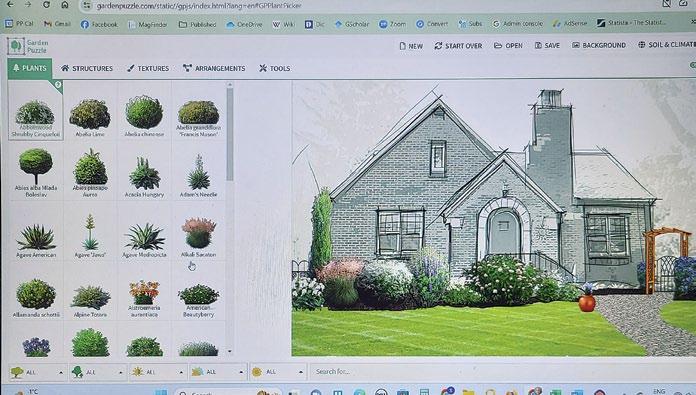
to start different seeds, whether to start them indoors or in the garden, when to transplant. You can journal your trials and tribulations and add photos.
This tool is more focused on personalized vegetable garden plans and less on the overall aesthetic design. It's great for planning and tracking the progress of your garden.
Garden Puzzle. I think this is the new iteration of Better Homes and Gardens Plan-a-Garden app. Now you have to pay for it.
It is straightforward. You take a picture of your house and garden and upload it. Ensure the picture includes everything you are designing and take it dead-on, if you can. Then you add plants and gazebos and walks to the picture as you see them, not in plan (from above) view. It’s kind of fun, but not very
precise. There are some ready-made plant groupings you can add, I’m pretty sure from Better Homes and Gardens.
iScape. This app makes everybody’s Top 10 List and I’m not sure why. The free version is only available on your smartphone. (They promised the new version could be used on a laptop but I’m not sure how to get it there.) Like Garden Puzzle, it works in 3D mode; you cannot design in 2D or plan mode.
They have a good selection of plants… presumably. I wasn’t able to get into an updated version of the app. You can add a plant by taking a picture of it, which is neat.
In the full version of the app, for US $30 per month, you can design in actual 3D, using your camera on your yard. I’m not too clear on how this works, but the video tutorial looks cool. f

Container plantings, whether they are hanging baskets, porch pots, or window boxes, are essentially a miniature version of a flower garden in concentrated form. Container gardens are usually focal points or even stand-alone yard décor, and so they need to make a strong visual statement. Also, the size constraints of a container garden limit the number of plants that can fit. Given these considerations, choosing plants and designs for these tiny gardens may seem intimidating, but in fact there are a few basic guidelines that will make this process enjoyable and the results stunning.
First a word about the container itself. I always feel it is best to err on the side of large instead of small when it comes to containers. A 14-inch diameter hanging basket is much easier to maintain than a 10-inch basket because it holds more soil and water. Container plants have nowhere to send roots for water, nutrients and
physical support other than what you provide within the confines of the container. For intense sun exposure, plastic and ceramic containers are preferable to wood or coco mat, the latter two being more subject to water loss through evaporation.
Using potting soil designed for containers is crucial to success and is money well spent. Purchased potting soil has excellent drainage, a pH in the range of 5.5 to 6.5, and is weed free. I prefer soils that do not have fertilizer already incorporated as that allows me to choose the amount and type (such as organic) of fertilizer based on the kind of plants and the growing environment. Mixing a tablespoon or two of a slow-release granular fertilizer with your soil before planting provides a small but constant dose of fertilizer. However, this does not replace regular additions of liquid fertilizer throughout the summer.



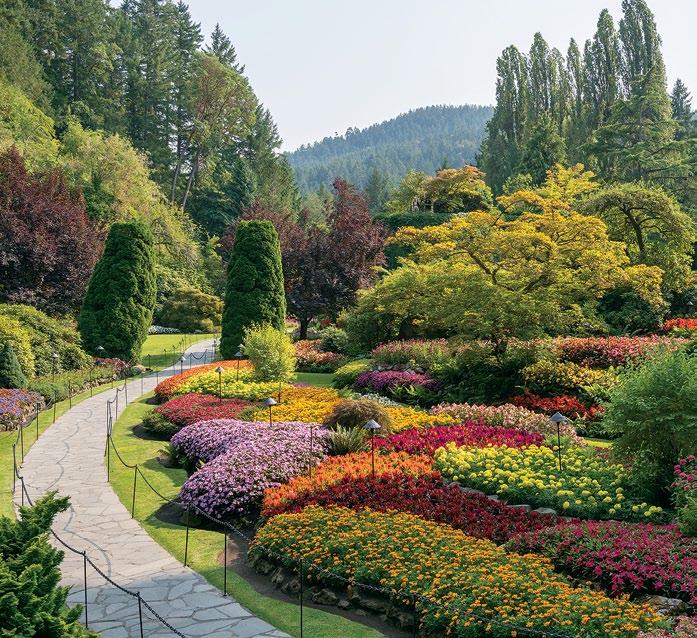
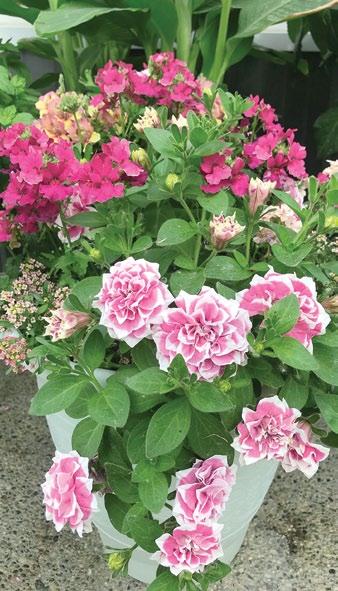
The colours in this planter are repeated with very different flower forms and sizes. The rosy hues of the double petunia ‘Pink Diamond’ match the pink nemesia and the white of the double petunia stands out against the yellows of the other nemesia and the multi-coloured sweet alyssum. Victoria
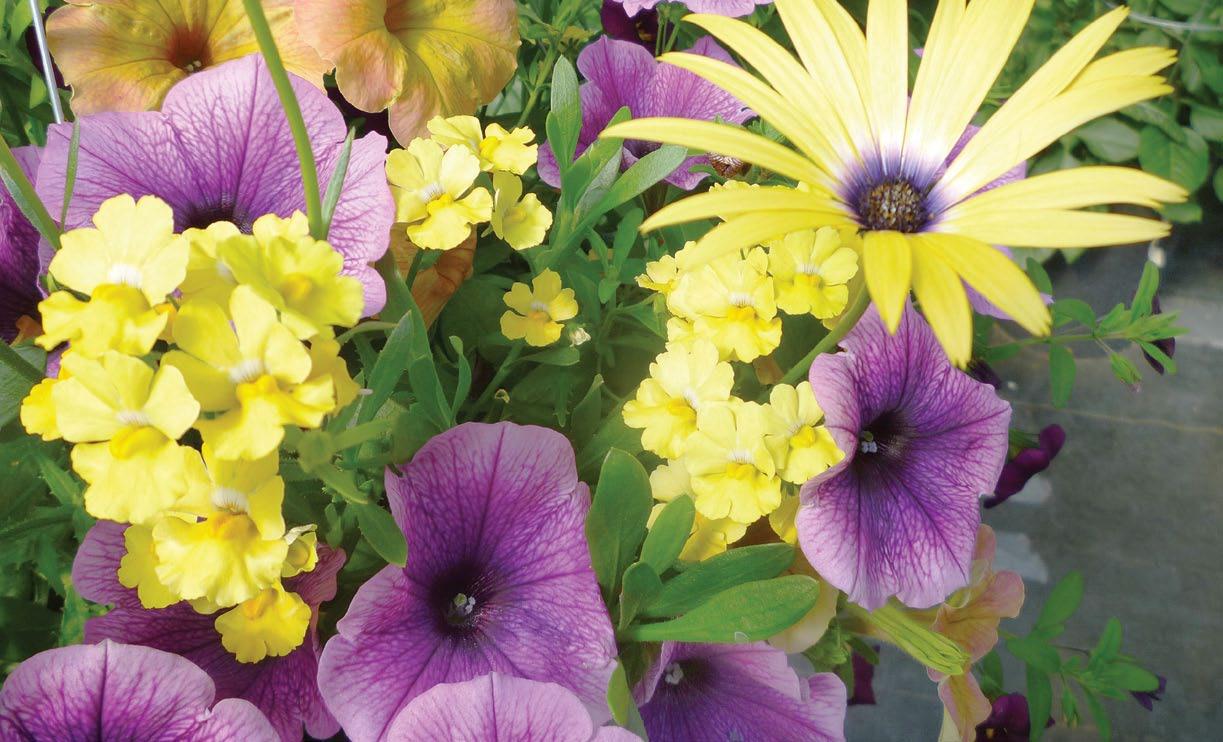
Choose plants whose light requirements match those of the site where the container will spend the growing season. Some plants are tolerant of both sun and shade, but most have a preference. Interior Alaska and northernmost parts of Canada experience a lower angle of the summer sun and longer day length which blurs the distinction between sun and shade, allowing shade plants to be planted in sunny locations and vice versa.
I always opt for the maximum number of plants I can fit in a container. If I am combining plants in 4-inch pots into a 14-inch container, I often use six or even eight to 10. Eight plants in one container provide a very full display, with plants knitting together and tumbling over the edge, making a stronger statement than the same number of plants divided between two planters.
The limited space and therefore limited number of plants in a container is where container design diverges from garden design. Each plant in a container must contribute to the maximum. Using a variety of flower colours, sizes, forms, and textures is an effective method for adding depth to a design, but unmanaged, this variety can instead add disorganization or confusion. The key to navigating this fine line and creating complexity rather than chaos is the use of repetition.
In any container, I always plan to repeat each colour at least twice but with flowers that are different shapes or sizes and even different hues of that colour. If repetition of a colour or family of colours has created a cohesive and complex visual result, it is possible to add in a contrasting colour that is represented only once. The result can be eye-catching. For example, add a yellow nemesia to a container in which purples, lavenders and whites are repeated by petunias, bacopa, and verbena. In the strong


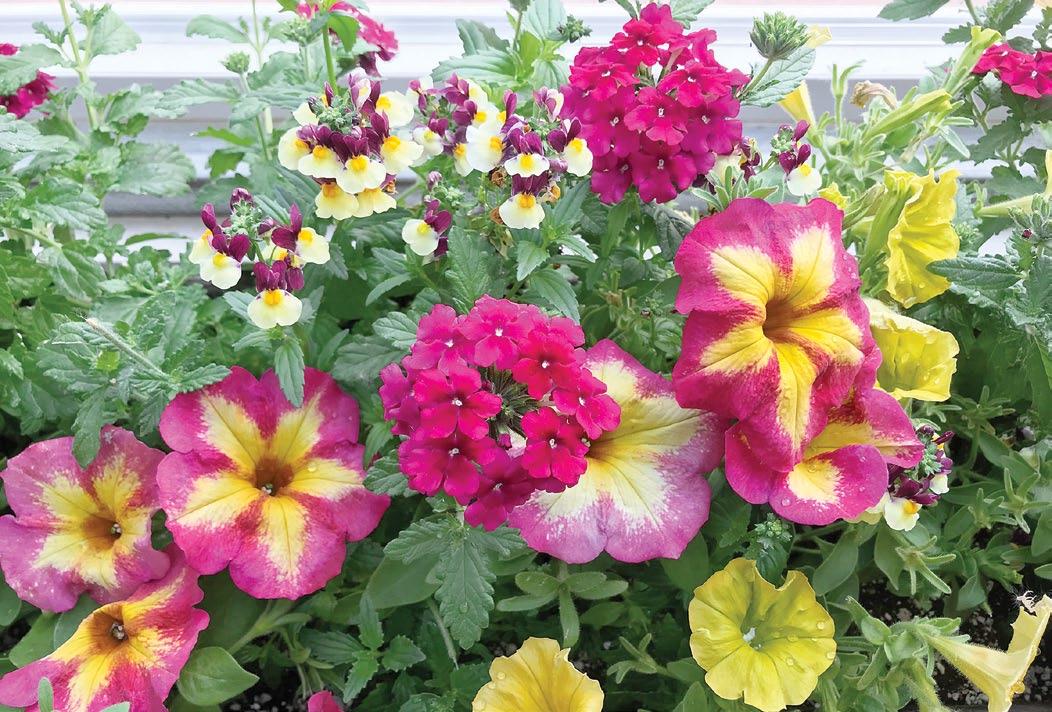

repetitive framework of lavenders and whites, the yellow functions as a welcome accent rather than as an addition to chaos as it might in a container that contained one each of pink, peach, lavender, and white flowers.
Another powerful tool in container design is the use of colour echoing, essentially a type of repetition. Flowers reflect light in different ways, so there are subtle differences among the multitude of flowers that we might categorize as “red” for example. Some might have more orange in them, some more blue. In a container, a red-orange petunia placed next to an orange calibrachoa, will read more orange than if it stands alone or is next to a purple (red-blue) calibrachoa. This echo or resonance of the orange of the calibrachoa with that same hue in the petunia increases the visual experience and hence the interest and complexity of the floral arrangement. The two flowers now provide three visual experiences: that of the petunia, that of the calibrachoa, and that of their interaction.
Some flowers are especially powerful as colour echoers because they contain multiple different colours in each blossom. Examples are the ‘Twinny’ variety of snapdragons, many of the nemesias, the picotee verbenas, and quite a few of the vegetative petunias. When these are components of a container planting, they may echo with some or all the other flowers in the arrangement and can thus create many visual experiences beyond the mathematical total of the plants.
Variety in both foliage and growth form of container plants also adds interest. Foliage can highlight blooms of neighbour plants and add a unifying backdrop. Combining contrasting growth forms, such as the pairing of dracaena with tuberous begonias, is an effective way to
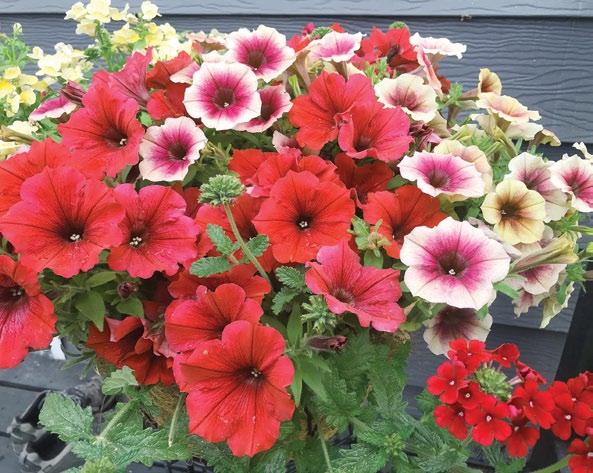
add excitement to any planting.
When a container is newly planted, even if it is a collection of sun-loving plants, it should be kept in a shady spot for a few days. One of the many types of porous lightweight overwintering fabrics can also be used for wind and cold protection during the transition to outof-doors. Failing to adhere to this hardening off process can cause the early demise of even the most beautifully designed container garden. f
Last fall, at the International Garden Tourism conference in Victoria, 10 Canadian public gardens were honoured with the title "Gardens Worth Traveling For". These are those gardens.

lethbridge, alberta
What are the essential elements of a Japanese garden? The tranquility and harmony created by thoughtful arrangement of natural elements: water, stone, sculpted plants and man made structures and art that blend into the landscape. All this, plus elements found only in the beautiful southern Alberta landscape are part of the Nikka Yuko Garden outside Lethbridge.
After 13 years of planning, the garden officially opened in 1967, Canada’s Centennial year. It was a gala affair attended by Prince and Princess Takamatsu of Japan.
The garden was the brainchild of a Japanese Canadian Buddhist priest
named Reverend Yutetsu Kawamura and his wife Yoneko. They were joined by Cleo Mowers, publisher of the Lethbridge Herald who saw the garden as a symbol of everlasting friendship and to commemorate the history of Japanese and European Albertans working and living and building a new province together since the early part of the 20th century. It was also a way to make amends for the cruel treatment the Japanese received during the Second Word War when the federal government rounded up all the Japanese in Canada, confiscated their belongings and sent them off to internment camps. Some of them were sent to work in the sugar beet factories in southern Alberta swelling


a small population of Nikkei Japanese who had worked on the railway to about 3,000 folks who world form the backbone of today’s community.
The garden was designed by Dr. Masami Sugimoto and Dr. Tadashi Kubo of Osaka Prefecture University in Japan. The resulting four acres of tranquility combine all those essential elements of any Japanese garden: a waterfall and stream and a reflective pond. There are forested spaces and meadows, exquisitely pruned trees and shrubs, art and practical objects such as lanterns, and carefully chosen and well-placed rocks brought from the nearby mountains. There is even a mini-island shaped like a turtle to

symbolize long life.
The beautiful Teahouse, situated on the margins of the reflective pond, was constructed according to Japanese building methods where no nails or screws are used. Called sashimono, this is a type of joinery using interlocking wooden joints. It is part of a philosophy that is focused on working with nature instead of against it. The architectural term is sukiya.
The entire garden is based on this principle and that may be part of the magic that visitors feel when in the garden.
The pavilion, shelter, bridges and gates were all built in Japan and reassembled on site.
Outside the Teahouse, is a stone pagoda, its five layers symbolizing earth, water, fire, wind, and sky.
The garden is meant to be experienced, so outdoor tea, for example, is a formal ceremony where you can taste matcha tea. This is a tea made from finely powdered tea leaves. Add hot water and whisk till frothy. It is said that this tea will lower blood pressure and reduce the risk of heart disease. There are yoga and meditation classes and a chance to wear an authentic Japanese kimono.
And for those who like something stronger than tea, every summer Saturday in late afternoon there is a happy hour from 4 till 7. f

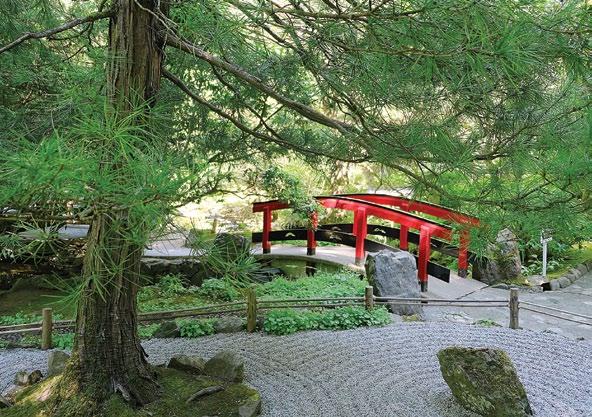
victoria

When Jenny and her husband Robert Butchart came to Victoria from their Ontario home in 1888, it was not with the idea of building a garden. They were manufacturers of Portland cement, then in great demand as North America was being developed at the time. So they bought a limestone quarry on the Saanich Peninsula of Vancouver Island and were up and running by 1904 with a quarry in Tod Inlet.
A few years later, Jenny commis-
sioned a Japanese gardener to build her a garden on the coast near their home. It is still there and is one of the nicest parts of the whole garden, its shade and tranquility very soothing after the riot of colour throughout the rest of the garden.
As quarries do, this one eventually ran out of limestone and Jenny hit upon the idea of turning the old quarry into a sunken garden, today the focal point for visitors from all over the world. The garden has now become five gardens, contain-

ing over 900 bedding plant varieties planted and cared for each year by 50 gardeners.
The first three gardens, created way back when Jenny was in charge, include the peaceful and shady Japanese Garden, the blazingly colourful Italian Garden, and the rose garden which today displays over 280 rose varieties on 2,500 plants.
More recently the Children’s Pavilion, filled with fascinating topiary, and the Mediterranean


Garden with 110 plant varieties that grow in that rather arid climate have been added.
In 1939, Jenny gifted the garden to her grandson Robert Ian Ross, the son of Jenny’s daughter, on his 21st birthday. He turned the garden into a commercial enterprise, running it until his death in 1997, when his son Christopher took over. Since Christopher died a short three years later, his sister, Robin-Lee Clarke has been running it. Robin has added the Children’s
Part of the magic of the garden is long family ownership. You can’t help but get that feeling of family intimacy there even though they have an enormous staff to care for the property.
Today, the garden is 120 years old. It has 26 greenhouses and 50 full time gardeners as well as staff in the gift shop, restaurant and gate. It in one of the iconic Canadian experiences which should be on everyone’s bucket list. f

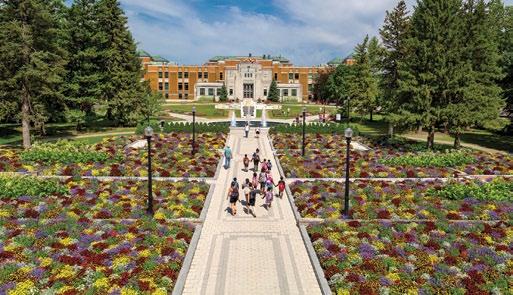


The Montreal Botanical Garden, situated near Olympic Park in Montreal, Quebec, stands as a testament to the city's dedication to preserving and showcasing plant life from around the globe. Founded in 1931 by Brother Marie-Victorin and designed by landscape architect Henry Teuscher, this extensive garden spans over 75 hectares and features a remarkable collection of over 22,000 plant species and cultivars, 10 exhibition greenhouses, more than 20 thematic gardens, and a vast arboretum.
As you enter the Montreal Botanical Garden, you're immediately transported into a world where the
harmony between art, nature, and science is palpable. The garden's thematic areas cater to various interests, showcasing everything from the meticulously pruned trees of the Japanese and Chinese Gardens to the lush foliage of the Tropical Rainforest housed within one of the greenhouses. The First Nations Garden pays homage to the indigenous peoples of Canada, reflecting on the deep connection with the land through the cultivation of native plants and traditional practices.
The Japanese Garden is an oasis of tranquility, featuring koi ponds, a traditional tea house, and a stunning


collection of bonsai and penjing. It provides a serene space for reflection and admiration of the meticulous garden design. Conversely, the Chinese Garden is inspired by the Ming Dynasty gardens, complete with a scholar's courtyard, pavilions, and a collection of penjing that depict miniature landscapes, blending art, philosophy, and nature.
The outdoor gardens also feature rose, alpine, aquatic, shade, shrubs and food gardens. There is a Monastery Garden and a Medicinal Plants Garden, and a Quebec Corner, featuring a small maplehickory forest, which is typical to the Montreal region. There is also a Garden of Innovations, which is replanted every year with new plants


on the market. This garden features new trends and is designed to be an inspiration for visitors.
Indoors, in a long complex, is a variety of gardens requiring different environments: one for arid regions, one for tropical rainforests and tropical food plants – where they grow oranges, bananas, coconuts and coffee – one for orchids, and so forth. The Botanical Garden also has 28 greenhouses behind the scenes, and together, the service and exhibition greenhouses grow over 5,000 kinds of plants, including more than 400 species of rare plants.
Sustainability and education are at the core of the Montreal Botanical Garden's mission. The garden not
only serves as a conservation center for endangered plant species but also as a research institution affiliated with the Université de Montréal. It offers a range of educational programs and workshops designed to inspire visitors of all ages to learn about plant biology, conservation, and the importance of biodiversity.
Visiting the Montreal Botanical Garden is an immersive experience that leaves a lasting impression on its visitors. Whether you're a nature enthusiast, a gardening aficionado, or simply seeking a peaceful retreat from the city's hustle and bustle, the garden offers a myriad of sights, scents, and sounds that invigorate the senses and foster a deeper appreciation for the natural world. f
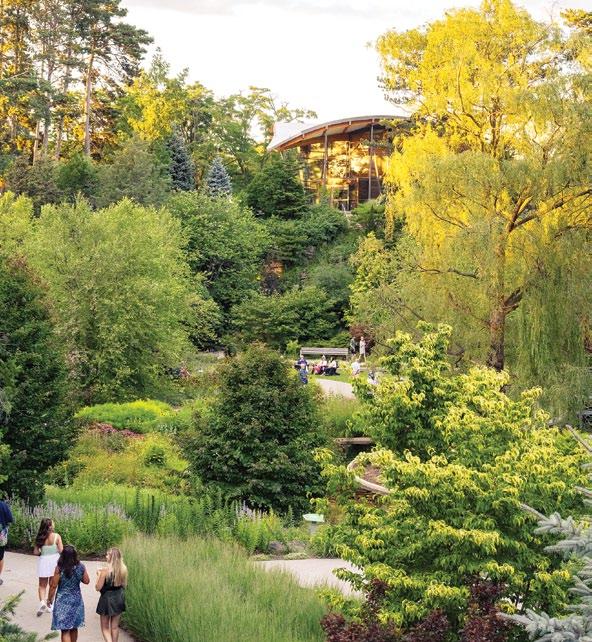



The Royal Botanical Gardens (RBG) straddles the border between Burlington and Hamilton in southern Ontario, standing as a testament to the beauty and diversity of the natural world. Stepping into this lush oasis feels like entering a secret realm where flora and fauna come together to create a harmonious symphony. The Gardens offer a captivating journey through its various areas, each offering a unique and enchanting experience.
Hendrie Park is the largest of the gardens and it encompasses 12 themed areas.
As one of the most iconic features of Hendrie Park, the Rose Garden is a fragrant masterpiece that beckons visitors with its stunning display of
roses in a multitude of hues. It was originally planted in 1965, but over time it became apparent that this monoculture of hybrid teas and floribunda roses was a magnet for insects and disease. It was closed for 2017 and reopened with a completely new beautiful and sustainable ecosystem that includes roses from the past 900 years as well as new Canadian varieties. Going from left to right, they are arranged from the Middle Ages through today.
Besides adding companion plants, there is now a trickle irrigation system, encouraging deeper and stronger roots. It is truly a rose garden for the 21st century.
One of the liveliest gardens is the Helen M. Kippax Garden, which is


an official Monarch Waystation that provides milkweeds, shelter and ideal nectar sources for the butterflies. Monarch butterflies, at the end of the summer, migrate all the way south to Mexico in a single generation. This garden is also popular with birds (it’s great for birdwatching) and other pollinators.
The Morrison Woodland Garden is full of understory plants from around the world. The Helen M. Kippax Garden contains all native plants (or at least plants that were in Ontario prior to the arrival of Europeans). There is a Lily Walk, a new Healing Garden and a Scented Garden, as well as a Global Garden, a White Garden and a Prehistoric Grove. Add to that the Veggie Village, the Dan Lawrie
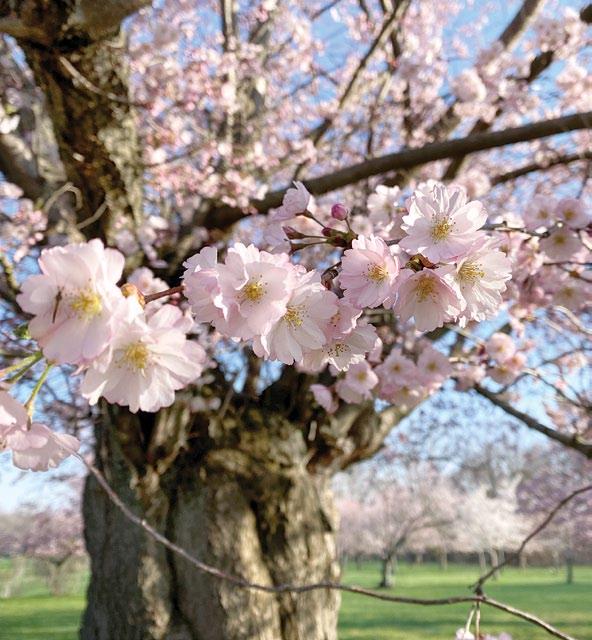

Sculpture Garden and the very ornate Hendrie Gates, and you have a daylong place to explore.
Nonetheless, a short stroll away from Hendrie Park lies the Laking Garden, with its peony, iris, hosta and clematis collections. It also includes the Barbara Laking Memorial Heritage Garden, featuring a “plants of necessity” area that tells of the plants that were used by Europeans for survival when they first came to Canada. This contrasts with the “garden of luxury”, where ornamental aesthetics take precedence. The two together form a seed and gene bank for the future.
You are not done yet, though. One of the highlights of the Gardens is the Rock Garden, the oldest garden
at RBG dating back to its opening in 1932. Here you will find water features and a waterfall, sculptures, a conifer collection, and plants of over 1600 types.
In addition to these three gorgeous areas, there is an arboretum, featuring collections of lilacs, magnolias, dogwoods and redbuds, crabapples, cherries and an area called The Pinetum.
And one more thing: there is the RBG Centre, an indoor garden, open year-round and absolutely worth a couple of hours or more. There are 1,256 varieties at the Centre, both outside and under cover inside the Centre. There is a Mediterranean Garden here, as well as the entrance to Hendrie Park. f




Memorial University Botanical Garden stands as a vibrant oasis of biodiversity, education, and serenity. Spread over 110 acres of land in St. John’s, Newfoundland, this enchanting botanical garden is not only a sanctuary for native flora but also a hub of learning and conservation efforts. It boasts a rich history and diverse plant collections, and it plays an invaluable role in both research and public education.
Memorial University Botanical Garden traces its roots back to the 1970s when Dr. Wilfred Templeman, a renowned botanist and professor at Memorial University, recognized the need for a dedicated space to study and conserve Newfoundland and Labrador's unique plant life. Thanks to his vision and efforts, the botanical garden officially opened its doors to the public in 1971.
Since its inception, the garden has
continually evolved, expanding its collection of native and exotic plants, developing educational programs, and becoming a vital resource for both the local community and researchers worldwide.
One of the most striking features of Memorial University Botanical Garden is its diverse plant collections. The garden boasts an impressive array of plant species, many of which are native to Newfoundland and Labrador. Visitors can explore themed gardens such as the Heritage Garden, which showcases traditional Newfoundland and Labrador crops, and the Lily Collection, home to a stunning variety of lilies from around the world.
Additionally, the garden houses a thriving alpine garden, a rock garden, a rhododendron garden, and an extensive collection of wildflowers. These collections not only provide



an aesthetic feast for the eyes but also serve as valuable resources for researchers and educators interested in local and global plant diversity.
Memorial University Botanical Garden plays a vital role in the conservation of Newfoundland and Labrador's native plant species. The Garden's staff and researchers are actively involved in seed banking, plant propagation, and habitat restoration projects to protect and preserve endangered or at-risk species. Their work contributes significantly to the conservation of the province's unique flora, ensuring that future generations can appreciate these natural wonders.
Education is a cornerstone of the Garden's mission. It offers a wide range of educational programs and resources for visitors of all ages, from school children to lifelong learners. The garden hosts guided tours, workshops, and lectures on topics ranging

from botany to horticulture, making it an ideal destination for both nature enthusiasts and students pursuing careers in the field of biology.
Furthermore, Memorial University Botanical Garden has a close relationship with Memorial University itself. It serves as an outdoor classroom and research facility for students and faculty members, fostering handson learning and scientific discovery. The Garden's dedication to education ensures that its impact extends far beyond its physical boundaries.
Beyond its educational and conservation roles, the botanical garden provides a peaceful and serene escape from the hustle and bustle of everyday life. Its well-maintained trails meander through lush greenery, allowing visitors to immerse themselves in nature, breathe in the fresh air, and find solace in the tranquil surroundings. Whether you're seek-
ing a moment of reflection, a leisurely walk, or a family outing, the garden offers a respite from the demands of modern living.
Memorial University Botanical Garden stands as a testament to the enduring beauty and importance of nature. With its rich history, diverse plant collections, conservation efforts, and commitment to education, it enriches the lives of both residents and visitors to Newfoundland and Labrador. Whether you're a botany enthusiast, a student of the natural sciences, or simply someone seeking a place of serenity and wonder, the garden invites you to explore its lush landscapes and discover the myriad treasures it holds. It is a living tribute to the remarkable biodiversity of this region and a testament to the power of human dedication to the preservation and celebration of the natural world. f


st. andrews, new Brunswick


Kingsbrae Garden was started by John and Lucinda Flemer and opened its doors in 1998. Not only would it preserve the family’s former estate, it would give employment to people in the area during the economic downturn of the time. Since then, it has been recognized by Trip Advisor as the number one thing to do in the area.
The Garden's name pays homage to its Scottish heritage; brae means a steep bank or hillside in Scots Gaelic. Kingsbrae Garden has been carefully developed over the years,
blending formal and informal designs with a focus on sustainability and environmental stewardship. It has been a beloved destination for tourists and locals since its first summer.
Visitors can explore a range of gardens, each with its own distinctive character. The Rose Garden, for example, showcases a stunning array of roses in various colours and varieties, offering a fragrant and visually captivating experience. The Heath and Heather Garden transports visitors to a picturesque Scottish landscape. Meanwhile,



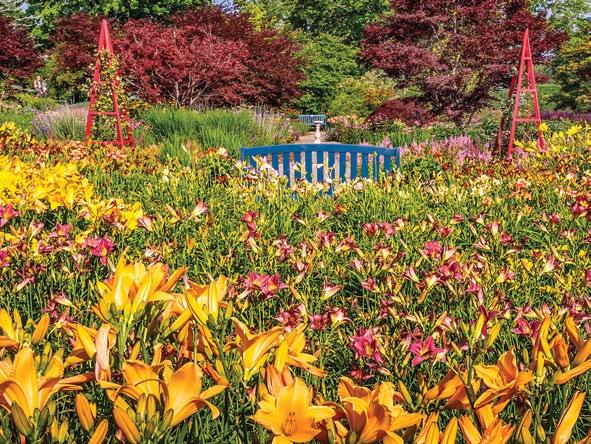
the Peace Garden is a serene area designed to welcome military veterans and first responders; it features an oak tree descended from one of the acorns collected from the battlefield at Vimy during the First World War.
There is also a Labyrinth and Maze, a Gravel Garden for alpine plants, and a Children’s Fantasy Garden, which features a series of playhouses and the “Mad Hatter’s Teapot Trees”. The Scents and Sensitivity Garden was developed in cooperation with the Canadian National Institute for the Blind and
the labels are engraved in Braille.
A working windmill is an icon of the garden. It is a one-third scale replica that was built in Holland and brought over as a gift from the Flemers. It is instrumental in circulating water between two ponds to keep it clean.
In addition to its botanical marvels, Kingsbrae Garden functions as a cultural hub. Throughout the summer season, the garden hosts a variety of events and activities, including art exhibitions, live music performances, and educational programs. These events enhance
the garden's appeal and encourage visitors to engage with the arts while surrounded by natural beauty.
Kingsbrae Garden places a strong emphasis on education, offering workshops, guided tours, and educational programs for all ages. Schools and community groups frequently visit the Garden to learn about horticulture, ecology, and sustainability practices. The Garden's dedication to environmental stewardship is evident in its sustainable gardening techniques, use of organic practices, and commitment to reducing its environmental footprint. f



Nestled in the heart of Nova Scotia, the Annapolis Royal Historic Gardens stands as a testament to the timeless beauty of meticulously cultivated landscapes. Though the first plantings were in the early 1980s, methods of gardening and popular plants from the 1600s through today and on to tomorrow are shown in various displays.
From the Heritage Rose Collection – featuring antique varieties and Canadian-developed roses – to the different historic gardens, adorned with heirloom plants reminiscent of bygone eras, each section tells a unique botanical story. The plant collections also include native species,
woodland gardens, and themed areas that showcase the beauty and resilience of plants.
There is the Acadian House with a thatched roof and surrounding potager, designed to look like a typical abode from 1671. Plants are based on research of journals from the era. There is an orchard around the back planted with varieties from the 1600s.
The Governor’s Garden is another of the historic gardens. Based on gardening concepts from the 1700s, it is surrounded by a formal evergreen hedge and filled with tidy blocks of herbs, flowers and heritage apple trees.
The Victorian Garden is full of colour and mimics a time when
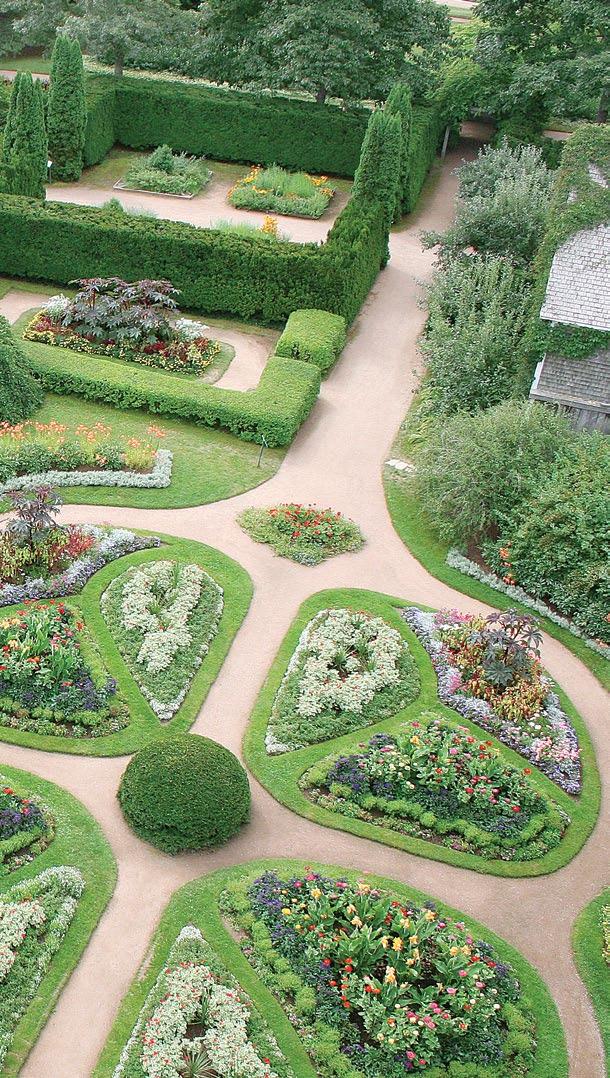
people were building ornamental gardens and planting flowers they gave romantic names, like love lies bleeding and forget-me-nots. There are also exotic plants brought home by explorers, like elephant ears, zonal geraniums and zinnias.
The Innovative Garden is like Tomorrowland in a Disney Park. They grow newer varieties of vegetables and flowers and grow according to different techniques. There are raised beds and a herb spiral, planting in a pallet and vertical gardens here.
Spring breathes in life with a riot of blossoms, from delicate tulips to vibrant daffodils, painting the landscape in a symphony of hues. Summer
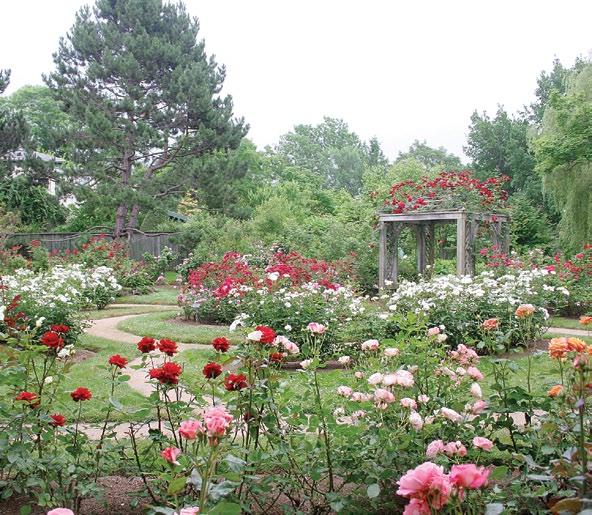

sees the gardens in full bloom, with the fragrant scent of roses and the gentle rustling of leaves creating an idyllic atmosphere. In autumn, the foliage transforms into a kaleidoscope of reds, oranges, and golds, captivating visitors with the beauty of nature's farewell. Winter, though a quieter period, unveils its own charm, with snow-covered landscapes and the promise of renewal.
Situated in zone 6, the Garden has some plants rarely seen in much of Canada. There is a beautiful display of golden chain trees (Laburnum), lacecap hydrangeas coloured blue by the acidic soil, pawpaw fruit trees, a rhododendron collection and magnolias.
Beyond its role as a stunning display of horticultural artistry, the Annapolis Royal Historic Gardens serves as an invaluable educational resource. Gardening enthusiasts and novices alike can partake in workshops, guided tours, and educational programs that explore various aspects of horticulture, from sustainable gardening practices to plant propagation techniques.
Gardens, like any living entity, require continuous care and preservation. The Gardens' commitment to preserving historical landscapes and horticultural traditions ensures that future generations can experience the same awe-inspiring beauty that has captivated visitors for decades. f


This garden in eastern Quebec began in 1926 when a 56-yearold woman was looking for something to do after surgery for appendicitis. Elsie Reford and her husband, who lived in Montreal, spent plenty of time in the area along the Métis River at a fishing lodge they owned. There they would catch salmon and hunt for deer, ducks and caribou.
Elsie was told by her doctor to take it easy; no more hunting and fishing, she should take up something relaxing like gardening. An indefatigable lady, Elsie set about the project in earnest. She began landscaping the area and
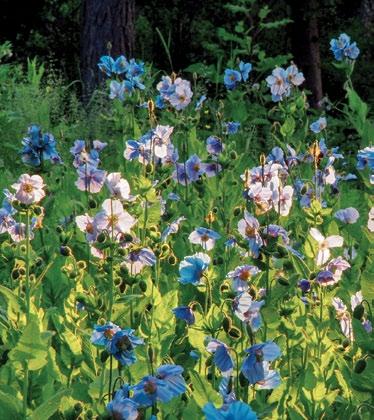
building soil that would grow English ornamental plants. She had the muscle power of the local men she hired to dig and move trees and boulders, but she did not know much at all about horticulture when she started. Over the next 30 years, she learned.
Today, Reford Gardens extends beyond horticulture into the realms of architecture, design, and community engagement. It is the site of the International Garden Festival, North America's largest contemporary garden festival. Each year, new international designers are selected to create eclectic installations that blend with the natural environment, living on for two to



three years – or more – as nature intertwines with the projects.
There are other things on the go at Reford, too. The conversion of a building on site into a center for innovation demonstrates the Gardens’ commitment to fostering interactions between people and the land. These initiatives not only contribute to the Gardens’ aesthetic and functional aspects but also support local artisans and entrepreneurs, creating a lasting legacy for the community.
Visiting Reford Gardens is an immersive experience that combines the beauty of nature with the inge-
nuity of human creativity. It's a place where history, art, and horticulture converge. Whether you're exploring the themed gardens, enjoying the contemporary garden installations, or savouring the culinary offerings, Reford Gardens offers a multifaceted experience that delights and inspires.
The Gardens now cover an area of 18 hectares and include more than 3,500 varieties and species of plants spread across 15 distinct gardens. Among them are the Entrance Garden, Alpine Garden, Stream Garden, and the Woodland Walk, each offering a unique experience with the lush flora. There is also a
museum of garden tools and an area filled with contemporary sculptures.
One of the highlights of Reford Gardens is the famous Blue Poppy collection. Elsie Reford was instrumental in popularizing the cultivation of Meconopsis betonicifolia, a striking blue flower (it isn’t actually a poppy) native to the Himalayas. The Gardens became known for successfully growing and displaying these vibrant blue flowers.
The Gardens are open only from the beginning of June through to the end of September, except for some Sundays when they open for activities like snowshoeing. Add it to the list of things you are waiting for this winter! f

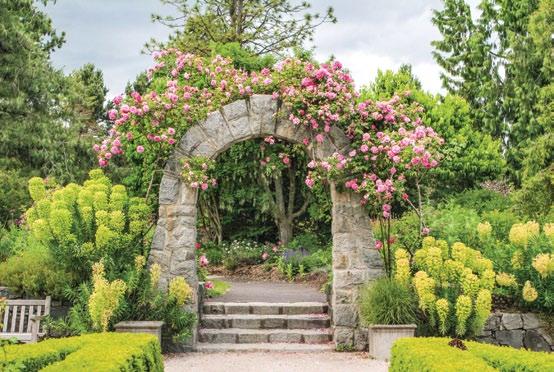

vancouver
There are many wonderful things to see at the VanDusen Botanical Garden in Vancouver. The 55 acres are home to some 40 specialty gardens featuring 7,500 species of flowering and other plants. But the highlight for many would be the trees.
Once part of a golf course owned by a CP Rail subsidiary, Marathon Realty, the garden was opened in 1975 with a $1 million donation from the Vancouver Foundation in the name of the Foundation founder, Julian VanDusen. The garden was designed by Bill Livingstone with the original flower gardens styled by Roy Forster, but it is the woody plant selec-
tion, including the trees that separate VanDusen from many other gardens.
The most obvious is the Elizabethan hedge maze created out of 3,000 pyramidal cedars planted in 1985. It can take the experienced maze-traveler 20 minutes from start to finish –maybe another 20 minutes to really explore it – or to find your way out. Fortunately, there is a viewing platform that allows the explorer to climb a set of stairs and get a bird’s eye view of the garden.
As visitors wander through the garden, they should be on the lookout for special trees, although special observation skills will not be necessary in May when the beautiful laburnums
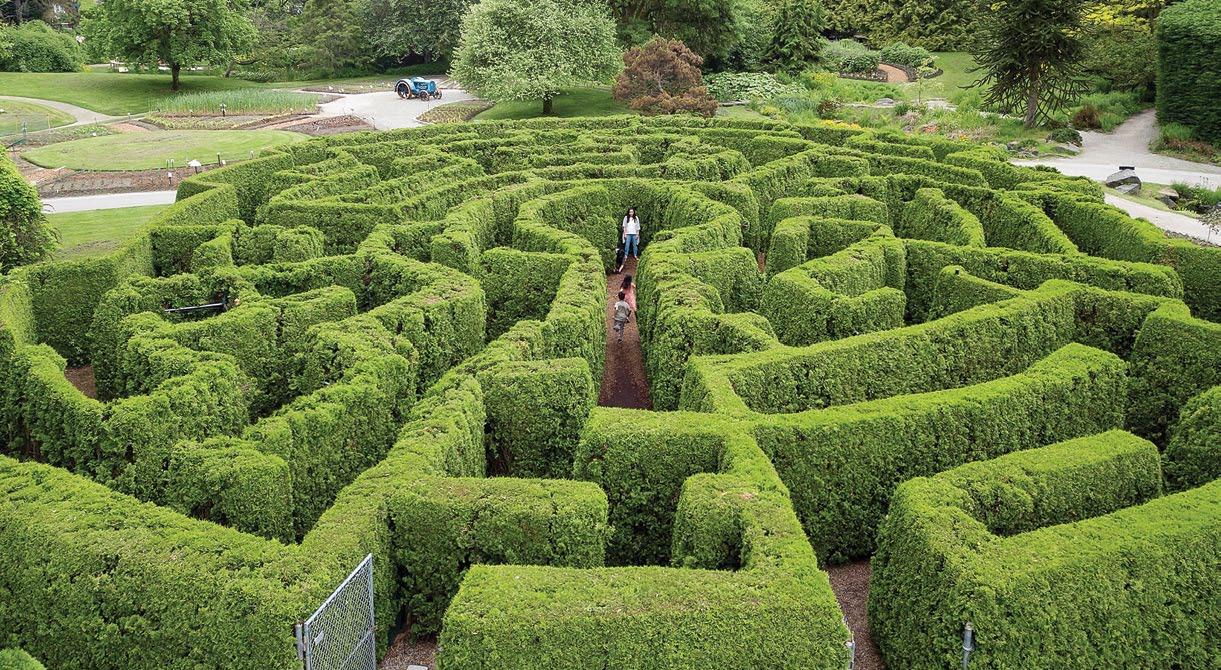


dip their golden chains into pools of purple allium, flanked by swathes of mauve Persicaria bistora and bluebells. On the Azalea Trail, the visitor rubs shoulders with azaleas and magnolia. The cherry grove is a heaven of scented pink, vying with a variety of flowering dogwood that punctuate the gardens.
It is the trees that you must seek out that can steal the show if you know what to watch for. Giant sequoia can hold secrets 3,000 years old. Towering red cedars, which can reach 230 feet in the air with a girth of 13 feet, stand out among the crowd. Beautiful Douglas fir is even larger than the others at 325 feet tall with an unbe-
lievable circumference.
More exotically in this garden wonderland, Japanese maples lend their sculpted beauty to many locations in the garden, but they can’t outshine the young monkey puzzle trees that can live up to 1000 years. This fascinating conifer, also known as a living fossil, has leaves that resemble those of some succulent species. They are arranged around the branches spirally, completely obscuring the stem. The leaves are pointy and stiff and live for up to 15 years. In nature, monkey puzzle trees grow very tall, and the branches extend only at the top of the trunk, but grown horticulturally the sculptural branches persist
at a lower level, allowing close scrutiny.
A wildflower garden is among the 40 specialty plantings which include a vegetable garden, a heather garden, and a Mediterranean garden to name just a few, nestled around the many small lakes and water features in the garden.
And when you have had your satisfaction from touring for hours, you can relax at the restaurant in the amazing Visitor Centre that is shaped like an orchid! Be sure to revisit in December when the light show is in play. In November 2023, Conde Nast named it one of the best such shows in the world. f



Unique in the world, the International Peace Garden straddles a border between two countries. You can move seamlessly between Canada and the U.S. thanks to an agreement back in 1932 when the National Association of Gardeners convinced both national governments plus the Province of Manitoba and the State of North Dakota to dedicate 2,300 acres to a garden to celebrate the pledge that appears on the cairn at the entry: “We two nations dedicate this Garden and pledge ourselves that, as long as man shall live, we will not take up arms against one another.”
On the day of dedication, 50,000 people came by Model T, horse and buggy and on foot to join the celebration, which culminated in a tug of war between the two nations. It was not recorded who won.
The Garden was designed along classical lines by Dr. Henry Moore, the author of the original concept and the garden largely remains true to the classical concept.
As you enter the Garden, the cairn on the US and Canadian border is flanked by the respective flags of the two countries. The cairn was constructed from aboriginal hammerheads gathered by local children. This is at the entrance to
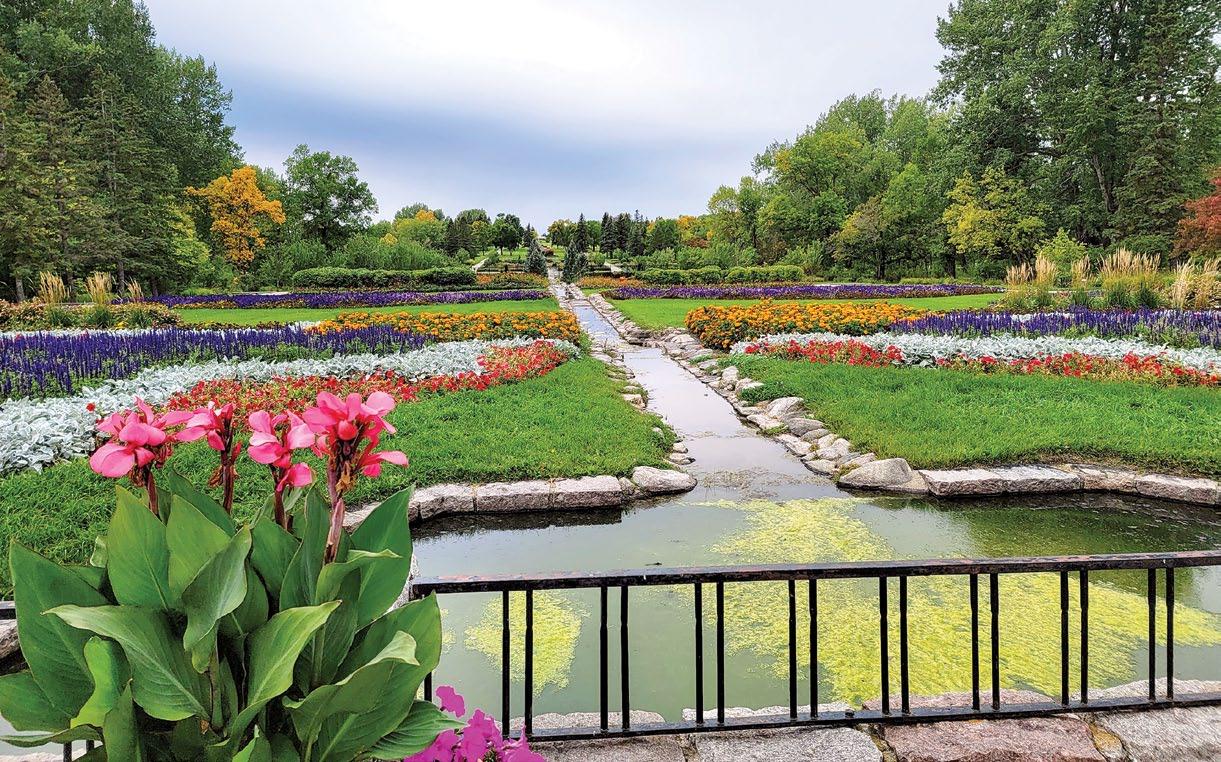
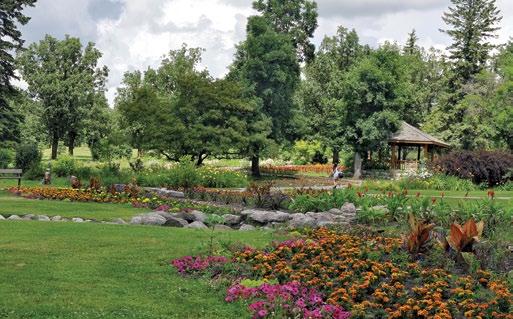
the Garden, and it leads to an overlook that takes the eye west down the border to the Peace Chapel at the far end of the garden, straddling the border.
The interior of the Chapel is clad in Tyndall Stone from Manitoba (the same stone that is found in the interior of the House of Commons), where words of wisdom by famous people, from Benjamin Franklin to Alexander Graham Bell and many more, are engraved. An organ stands ready for someone to release its glorious sound to the congregation.
A series of five terraces lead from
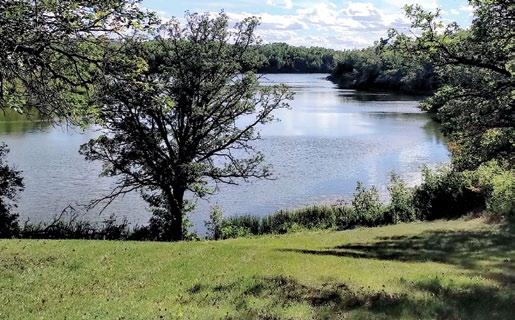
the Peace Chapel at west end of the Garden to the sunken garden centered on the international border. As you meander eastward back toward the gate, on the south path you will encounter a symbol of peace and democracy in some twisted girders from the 911 attack on the New York Twin Towers. If you are taking the northern side path, you will come across the Carillon Bell Tower which rings out the Westminster chimes every 15 minutes.
Between the pathways, the cascade runs down the border to a pool at the centre of the garden.
The stream is flanked by formal annual gardens and near the gate to the sunken garden, two special plantings imitate the flags of the respective countries. The sunken garden features a large pool with a fountain, flanked by smaller pools at the north and south axis. The pools are surrounded by a beautiful perennial garden that changes from season to season.
At the south end of this central area, stands the Interpretive centre, opened in 2010, and the attached new conservatory housing one of North America’s most diverse collections of cactus and succulents.
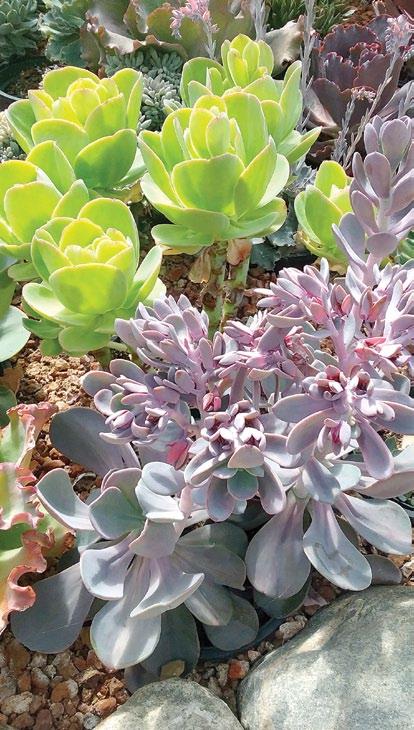

Wandering back to the Eastern Gateway, you leave the sunken garden but, wait … here, nestled under the shade of some sheltering trees, is the children’s nature playground, a child’s delight with the play areas mimicking local animals – turtles, eagles and so on.
The Garden also features the famous working floral clock, 15 feet in diameter and decorated with 3,000 plants. A satellite regulates the clock's time through a GPS system.
The Peace Garden is also home of the Game Wardens Museum, which houses a wide variety of animal pelts, horns, and antlers for visitors to see and touch.
Overall, there are about 200 buildings on the site of the Peace Garden including the Historic Lodge built in 1937 and the first building on the site. Constructed of peeled logs harvested from Manitoba’s Duck Mountain and set on a base of North Dakota granite, the lodge is 105 feet long with a 60-foot wing. Giant stone fireplaces dominate each of the rooms.
Many scenic picnic grounds, a



large, fully equipped campground with capacity to handle modern campers, kayak rentals, hiking trails – all these are part of the garden.
The International Peace Garden is also home to the International Music Festival which sees some 2,000 children attend camp there each summer. In addition, there are miles of hiking trails around two lakes with many animal and bird species to discover.
The International Peace Garden is located on Turtle Mountain, a rise in the prairies that was historically unclaimed by any Indigenous tribe (although the Dakota and Métis did create settlements on the verges in the latter part of the 19th century). Instead, legend has it that Turtle Mountain was used as the meeting place for warring tribes to come together to settle differences. It is romantic to believe that the site of the Peace Garden was somehow ordained. Just 30 miles from the geographical center of the continent, Turtle Mountain and the Garden is a part of the land that breathes peace. f
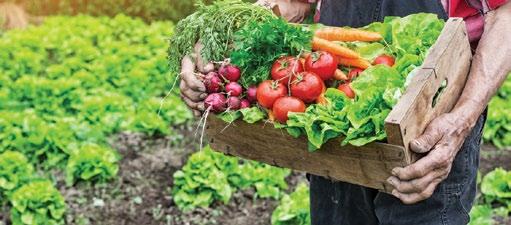
A great yard or garden begins with a great foundation. Reimer Soils has been providing the highest quality landscaping products for more than 40 years. With a complete range of top quality products and unmatched customer service, there is no reason to look any further than Reimer Soils for all your landscaping supply needs.

